Vol. 69, No. 24 (2020)
2020-12-20
INVITED REVIEW

COVER ARTICLE
2020, 69 (24): 248702.
doi:10.7498/aps.69.20201631
Abstract +
Laws of physics govern all forms of matter movement. However, lives, which are composed of chemical elements which everyone is familiar with, are largely beyond physical description available. This is because the construction of life is not the same as that of general matters, rendering it unknown how physics laws are utilized. In this paper, we present our thinking on the transcriptional apparatus (TA). The TA is a huge molecular machine acting to sense regulatory signals and initiate transcripts at right time and with right rate. The operation of the TA is fundamental to almost all forms of lives. Although great progress has been made in recent years, one often has to face contradictory conclusions from different studies. Additionally, the studies of transcription are divided into several fields, and different fields are increasingly separate and independent. Focusing on eukaryotic transcription, in this review we briefly describe major advances in various fields and present new conflicting view points. Although the structural studies have revealed the main components and architecture of the TA, it is still unclear how the Mediator complex transmits signals from activators to the core transcriptional machinery at the promoter. It is believed that the Mediator functions to recruit RNA polymerase II onto the promoter and promote the entry into transcriptional elongation, which fails to explain how the signal transduction is achieved. On the other hand, the allostery effect of the Mediator allows for signal transmission but is not supported by structural study. It is reported that enhancers, especially supper enhancers, act to recruit activators via forming a so-called liquid drop and phase separation. By contrast, it is suggested that enhancers should cooperate delicately to orchestrate transcription. Results on the kinetics of protein-promoter interaction also contrast with each other, leading to a paradox called “transcriptional clock”. It is then concluded that proteins interact frequently and transiently with promoters and different proteins interact with the promoter at different stages of transcriptional progression. The phenomenon of transcriptional burst questions how the cellular signaling is achieved through such a noisy manner. While the burst frequency or size, or both are potentially modulated by transcriptional activators, more evidence supports the mode of frequency modulation. The technical difficulties in investigating the mechanism of transcription include 1) structural characterization of flexible and/or unstable proteins or protein complexes, 2) measurement of intermolecular kinetics, 3) tracking of single molecule movement, and 4) lack of methodology in theoretical research. We further propose a research strategy based on the ensemble statistical method, and introduce a model for how the TA dynamically operates. The model may act as a benchmark for further investigations. The operating mechanism of the TA should reflect an optimal use of physics laws as a result of long-term biological evolution.
REVIEW
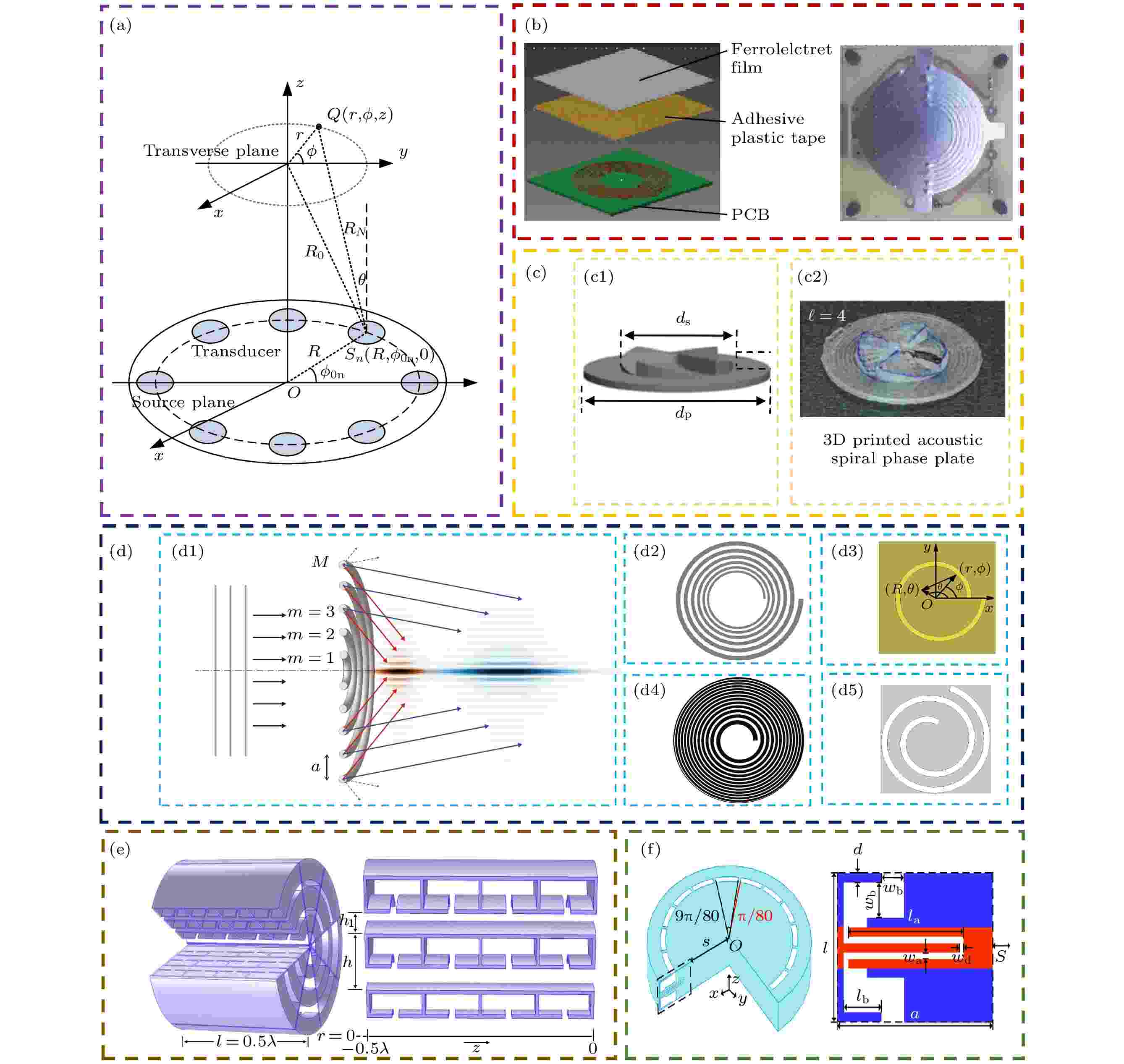
2020, 69 (24): 244301.
doi:10.7498/aps.69.20200826
Abstract +
The orbital angular momentum (OAM) carried by acoustic vortex beam can be transmitted to objects, which has a good application prospect in particle manipulation. In addition, the acoustic vortex beam also has great potentials in acoustic communication. The acoustic vortex beams with different OAM modes are orthogonal to each other, so the OAM mode can be introduced into the traditional acoustic communication, which provides a potential solution for realizing the high-speed, large-capacity and high-spectral efficiency of underwater acoustic communication technology in future. In this paper, we summarize the research progress of acoustic vortex beam, in which we mainly introduce the generation and detection scheme of acoustic vortex beam, its transmission characteristics, and its typical research cases in communication. Finally, the future development trend and the outlook of acoustic vortex beam are also analyzed and prospected.
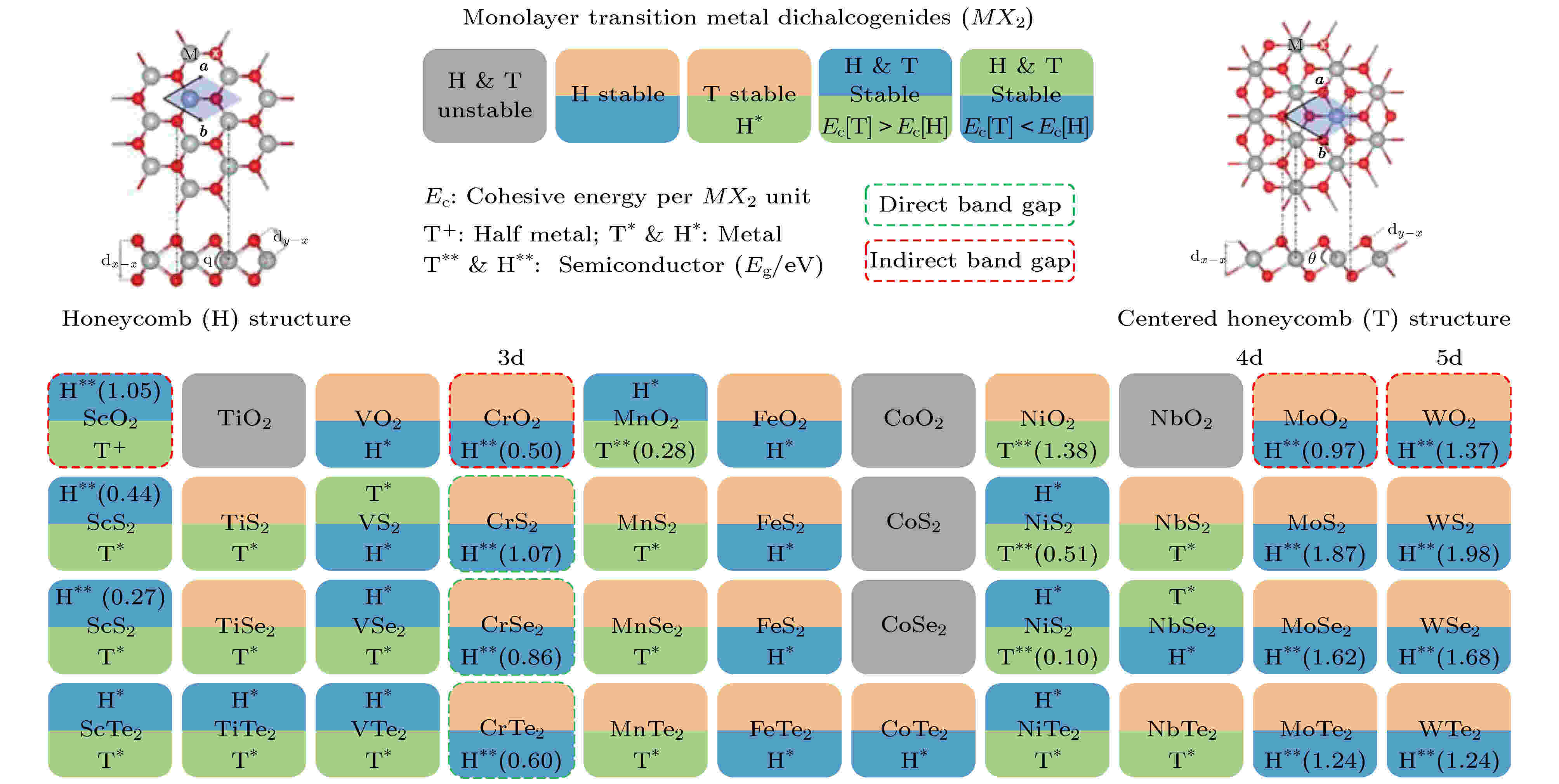
2020, 69 (24): 246101.
doi:10.7498/aps.69.20200965
Abstract +
Following traditional semiconductors such as silicon and GaAs, in recent years the two-dimensional materials have attracted attention in the field of optoelectronic devices, thermoelectric devices and energy storage and conversion due to their many peculiar properties. However, the normal two-dimensional materials such as graphene, cannot be well used in the field of optoelectronics due to the lack of a band gap, and the black phosphorus is also greatly limited in practical applications due to its instability in the air. The two-dimensional transition metal dichalcogenides have attracted more attention due to the different atomic structures, adjustable energy band and excellent photoelectric properties. There are different crystal phases in transition metal dichalcogenides, some of which are stable in the ground state, and others are instable. Different phases exhibit different characteristics, some of which have semiconductor properties and others have like metal in property. These stable and metastable phases of transition metal dichalcogenides can be transformed into each other under some conditions. In order to obtain these metastable phases, thereby modulating their photoelectric performance and improving the mobility of the devices, it is essential to obtain a phase transition method that enables the crystal phase transition of the transition metal dichalcogenides. In this article, first of all, we summarize the different crystal structures of transition metal dichalcogenides and their electrical, mechanical, and optical properties. Next, the eight phase transition methods of transition metal dichalcogenides are listed, these being chemical vapor deposition, doping, ion intercalation, strain, high temperature thermal treatment, laser inducing, plasma treatment, and electric field inducing. After that, the research progress of these phase transition methods and their advantages and disadvantages are introduced. Finally, we sum up all the phase transition methods mentioned in this article and then list some of the problems that have not been solved so far. This review elaborates all of the presently existing different phase transition methods of transition metal dichalcogenides in detail, which provides a good reference for studying the phase transition of transition metal dichalcogenides in the future, the electrical performance regulated by different phases, and the applications of memory devices and electrode manufacturing.
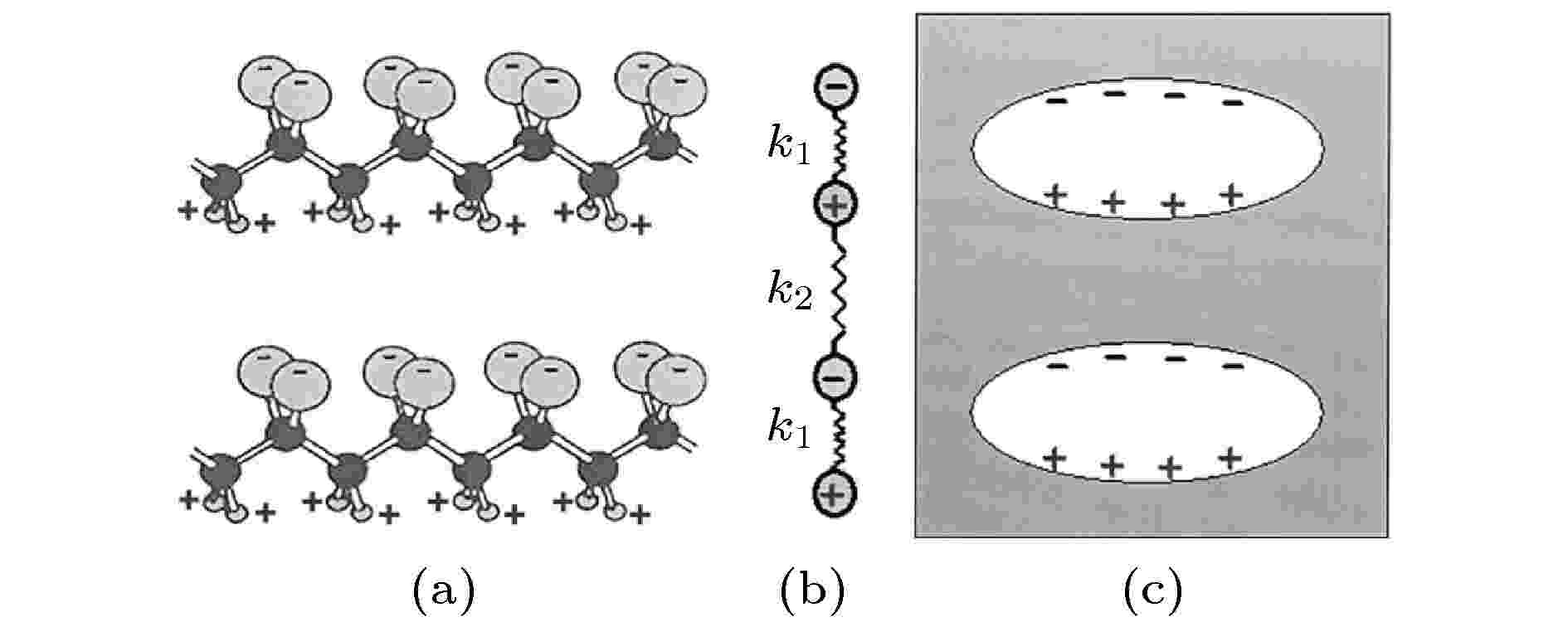
2020, 69 (24): 247701.
doi:10.7498/aps.69.20200815
Abstract +

EDITOR'S SUGGESTION
2020, 69 (24): 248901.
doi:10.7498/aps.69.20201119
Abstract +
Predicting human mobility between locations is of great significance for investigating the population migration, traffic forecasting, epidemic spreading, commodity trade, social interaction and other relevant areas. The intervening opportunity (IO) model is the model established earliest from the perspective of individual choice behavior to predict human mobility. The IO model takes the total number of opportunities between the origin location and the destination as a key factor in determining human mobility, which has inspired researchers to propose many new IO class models. In this paper, we first review the research advances in the IO class models, including the IO model, radiation class models, population-weighted opportunity class models, exploratory IO class models and universal opportunity model. Among them, although the IO model has an important theoretical value, it contains parameters and has low prediction accuracy, so it is rarely used in practice. The radiation class models are built on the basis of the IO model on the assumption that the individual will choose the closest destination whose benefit is higher than the best one available in origin location. The radiation class models can better predict the commuting behavior between locations. The population-weighted opportunity class models are established on the assumption that when seeking a destination, the individual will not only consider the nearest locations with relatively large benefits, but also consider all locations in the range of alternative space. The population-weighted opportunity class models can better predict intracity trips and intercity travels. The exploratory IO class models are built on condition that the destination selected by the individual presents a higher benefit than the benefit of the origin and the benefits of the intervening opportunities. The exploratory IO class models can better predict the social interaction between individuals, intracity trips and intercity travels. The universal opportunity model is developed on the assumption that when an individual selects a destination, she/he will comprehensively compare the benefits between the origin and the destination and their intervening opportunity. The universal opportunity model presents a new universal framework for IO class models and can accurately predict the movements on different spatiotemporal scales. The IO class models have also been widely used in many fields, including predicting trip distribution in transportation science, modeling the purchasing behaviors of consumers in economics, detecting complex network communities in network science, measuring spatial interaction in economic geography and predicting infectious disease transmission in epidemiology. This paper focuses on the applications of IO class models in spatial interaction and epidemic spreading, and finally presents the discussion on the possible future research directions of these models.
GENERAL
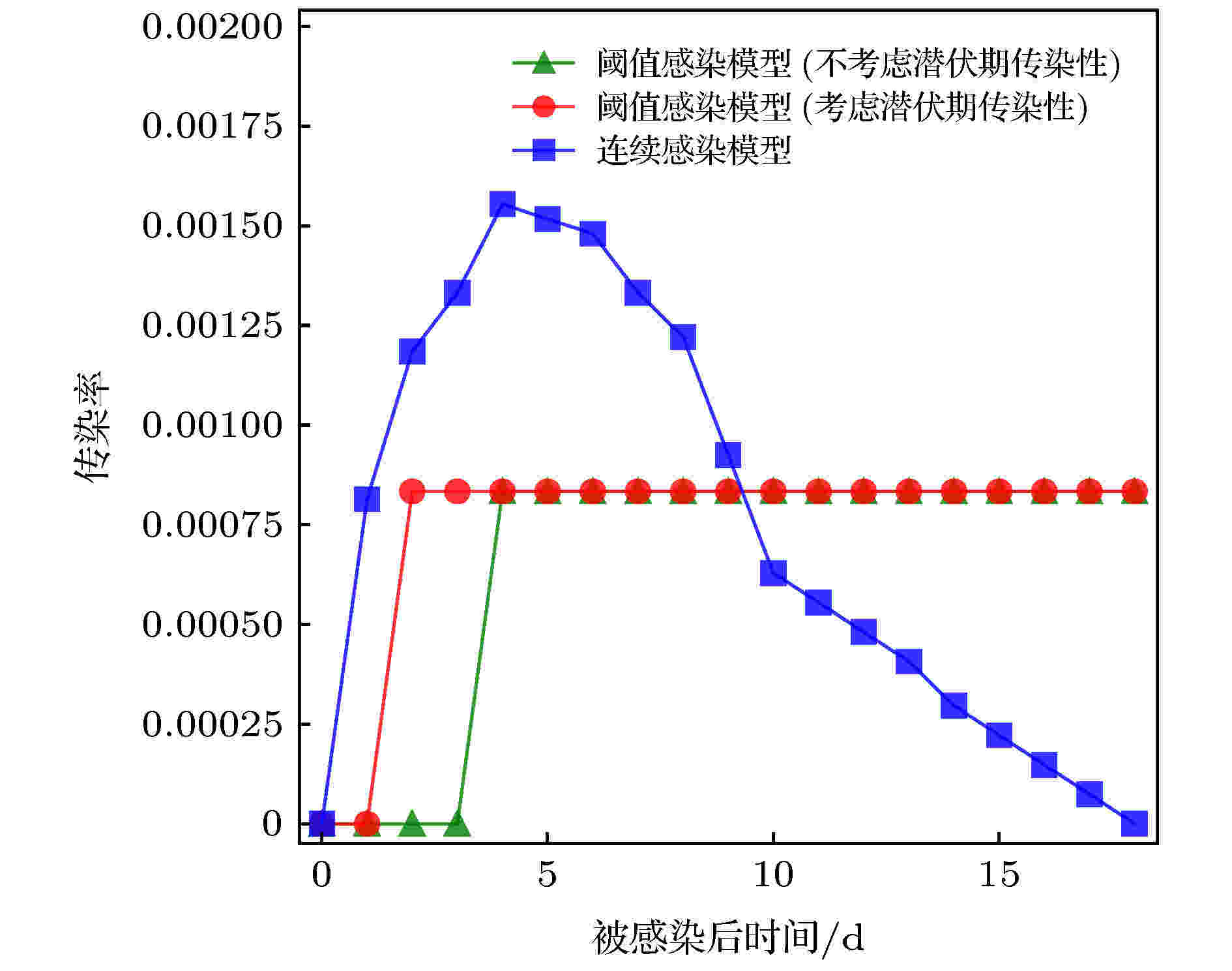
2020, 69 (24): 240201.
doi:10.7498/aps.69.20201106
Abstract +
After the COVID-19 epidemic leveled off in China, many provinces have started to resume schooling. Long-term contact between students and teachers in such a closed environment in schooling can increase the possibility of the outbreak. Although the school closure can effectively alleviate the epidemic, large-scale students’ isolation not only causes social panic but also brings huge social and economic burden, so before the emergence of school epidemics, one should select and adopt more scientific prevention and control measures. In this study, according to the virus excretion of COVID-19 patients in the disease period, the infectious capacity of patients is redefined. After introducing it into the traditional suspected-exposed-infected-removed (SEIR) model, a continuous infection model that is more consistent with the actual transmission of COVID-19 patients is proposed. Secondly, the effective distance between students is calculated through real contact data. Based on the analysis of the effective distance, three types of isolation area prevention and control measures are proposed and compared with the recently proposed digital contact tracking prevention and control measures. Simulating the spread of COVID-19 in schools through real student contact data and continuous infection models, in order to compare the preventions and control effects of various prevention and control measures in the school epidemic situation, and evaluating the social influence of measures by accumulating the number of quarantines when prevention and control measures are adopted, we find that the COVID-19 can lead the cases to happen on a larger scale in the continuous infection model than in the traditional SEIR model, and the prevention and control measures verified in the continuous infection model are more convincing. Using digital contact tracking prevention and control measures in schools can achieve similar results to those in closed schools with the smallest number of quarantines. The research in this paper can help schools choose appropriate prevention and control measures, and the proposed continuous infection model can help researchers more accurately simulate the spread of COVID-19.
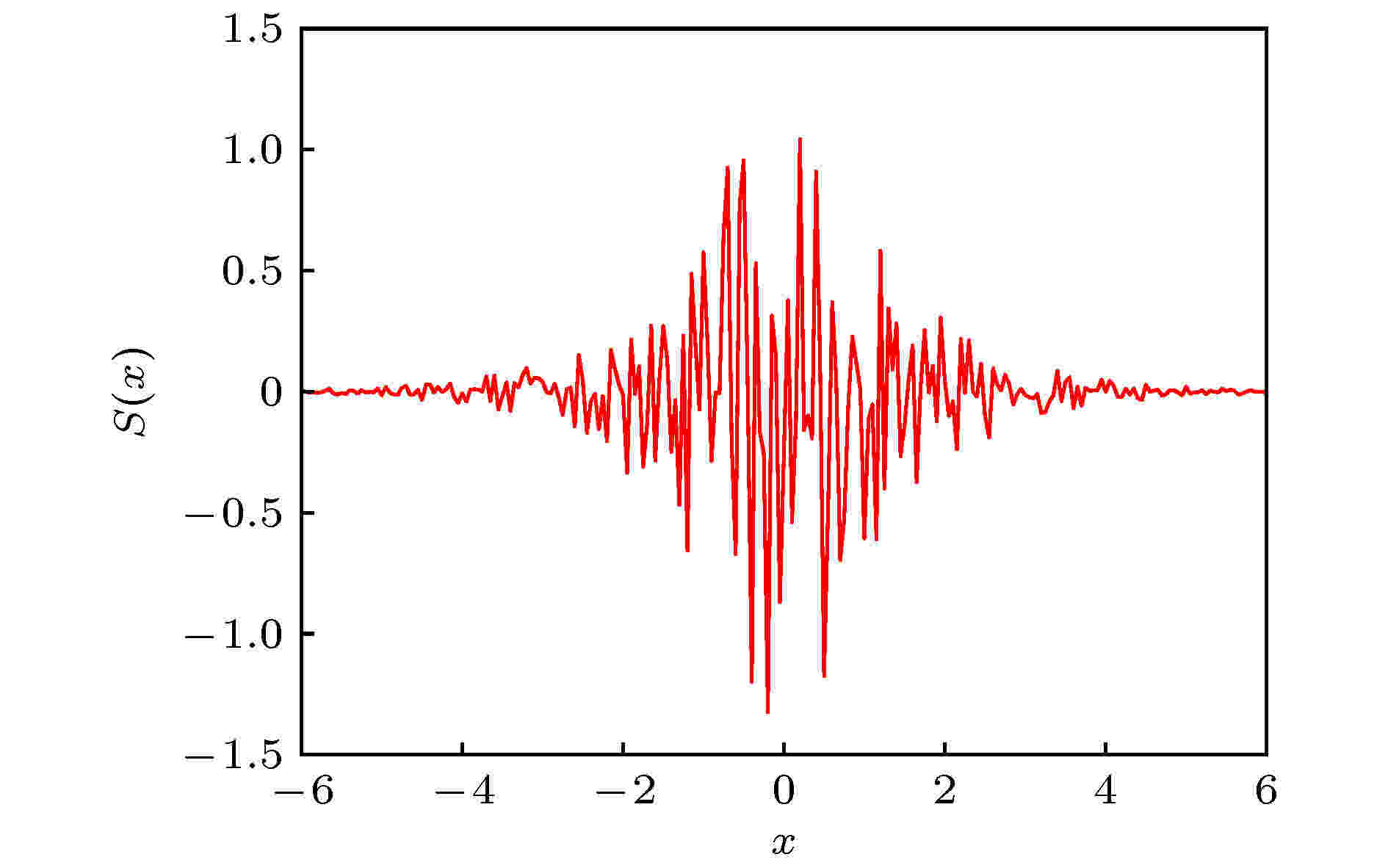
2020, 69 (24): 240501.
doi:10.7498/aps.69.20200725
Abstract +
A large number of animal experiments show that there is irregular chaos in the biological nervous systems. An artificial chaotic neural network is a highly nonlinear dynamic system, which can realize a series of complex dynamic behaviors, optimize global search and neural computation, and generate pseudo-random sequences for information encryption. According to the superposition theory of sinusoidal signals with different frequencies of brain waves, a non-monotone activation function based on the multifrequency-frequency conversion sinusoidal function and a piecewise function is proposed to make a neural network more consistent with the biological characteristics. The analysis shows that by adjusting the parameters, the activation function can exhibit the EEG signals in its different states, which can simulate the rich and varying brain activities when the brain waves of different frequencies and types work at the same time. According to the activation function we design a new chaotic cellular neural network. The complexity of the chaotic neural network is analyzed by the structural complexity based SE algorithm and C0 algorithm. By means of Lyapunov exponential spectrum, bifurcation diagram and basin of attraction, the effects of the activation function’s parameters on its dynamic characteristics are analyzed in detail, and it is found that a series of complex phenomena appears in the chaotic neural network, such as many different types of chaotic attractors, coexistent chaotic attractors and coexistence limit cycles, which improves the performance of the chaotic neural network, and proves that the multi-frequency sinusoidal chaotic neural network has rich dynamic characteristics, so it has a good prospect in information processing, information encryption and other aspects.

2020, 69 (24): 240502.
doi:10.7498/aps.69.20201019
Abstract +
Many image compression and encryption algorithms based on traditional compressed sensing and chaotic systems are time-consuming, have low reconstruction quality, and are suitable only for grayscale images. In this paper, we propose a general image compression encryption algorithm based on a deep learning compressed sensing and compound chaotic system, which is suitable for grayscale images and RGB format color images. Color images can be directly compressed and encrypted, but grayscale images need copying from 1 channel to 3 channels. First, the original image is divided into multiple 3 × 33 × 33 non-overlapping image blocks and the bilinear interpolation Bilinear and convolutional neural network are used to compress the image, so that the compression network has no restriction on the sampling rate and can obtain high-quality compression of image. Then a composite chaotic system composed of a two-dimensional cloud model and Logistic is used to encrypt and decrypt the compressed image (sliding scrambling and vector decomposition), and finally the decrypted image is reconstructed. In the reconstruction network, the convolutional neural network and bilinear interpolation Bilinear are mainly responsible for reconstructing the contour structure information, and the fully connected layer is mainly responsible for reconstructing and combining the color information to reconstruct a high-quality image. For grayscale images, we also need to calculate the average value of the corresponding positions of the 3 channels of the reconstructed image, and change the 3 channels into 1 channel. The experimental results show that the general image encryption algorithm based on deep learning compressed sensing and compound chaos system has great advantages in data processing quality and computational complexity. Although in the network the color images are used for training, the quality of grayscale image reconstruction is still better than that of other algorithms. The image encryption algorithm has a large enough key space and associates the plaintext hash value with the key, which realizes the encryption effect of one image corresponding to one key, thus being able to effectively resist brute force attacks and selective plaintext attacks. Compared with it in the comparison literature, the correlation coefficient is close to an ideal value, and the information entropy and the clear text sensitivity index are also within a critical range, which enhances the confidentiality of the image.
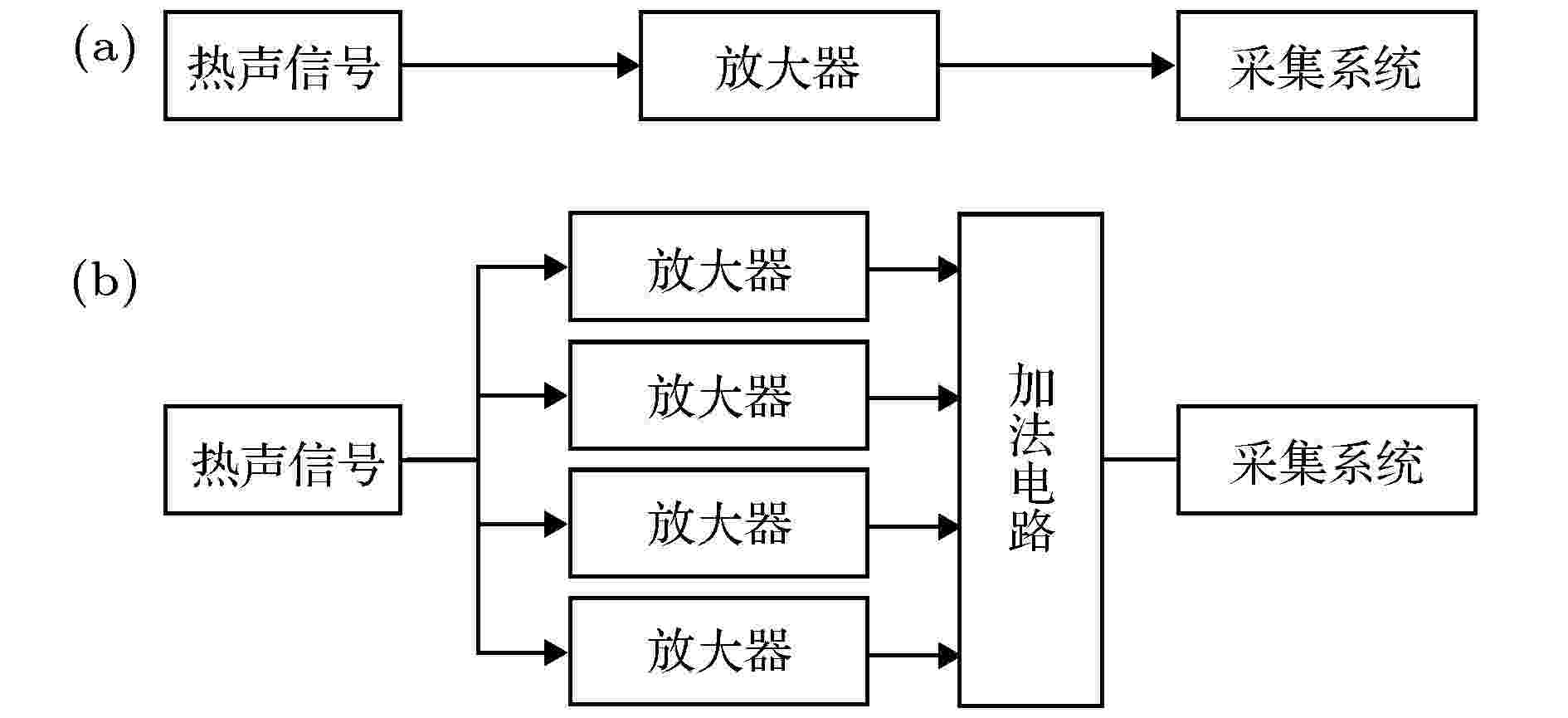
EDITOR'S SUGGESTION
2020, 69 (24): 240701.
doi:10.7498/aps.69.20201036
Abstract +
NUCLEAR PHYSICS
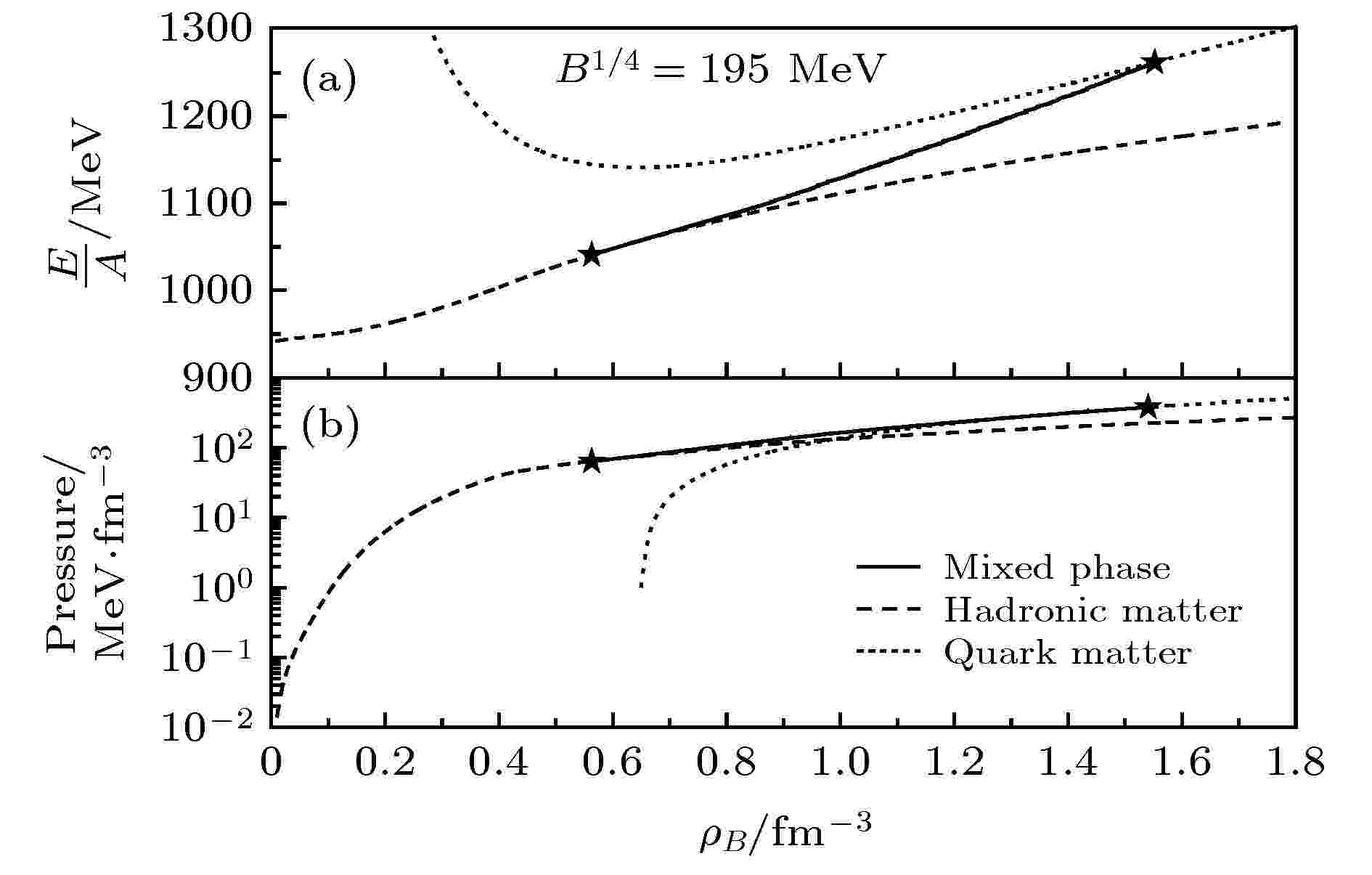
2020, 69 (24): 242101.
doi:10.7498/aps.69.20200925
Abstract +
Astronomical statistics shows that the mass of neutron star is of the order of the solar mass, but the radius is only about ten kilometers. Therefore, the neutron star is highly condensed and there may be a variety of competing material phases inside the compact star. Hadron-quark deconfinement phase transition that is poorly understood at high density can be studied by the matter properties of hybrid star. The hybrid star contains many kinds of material phases, which cannot be described uniformly by one theory. So, different material phases are described by different theories. The hadronic phase is described by the relativistic mean-field theory with parameter set FSUGold includingω2ρ2interaction term, and the quark phase is described by an effective mass bag model in which the quark mass is density-dependent. The hadron-quark mixed phase is constructed by the Gibbs phase transition, and the properties of hybrid star inβequilibrium is studied in this model. It is found that the bag constantBhas a great influence on the starting point and ending point of the hadron-quark deconfinement phase transition and the particle composition in the hybrid star. Comparing with the starting point of phase transition, the influence ofBon the ending point of phase transition is very obvious. For the hybrid star, the equation of state of matter becomes stiffer at low density and softer at high density asBincreases. The overall effect is that the slope of the mass-radius curve increases withBincreasing. The calculated results show that the maximum mass of hybrid star is between 1.3 solar mass and 1.4 solar mass (M☉), and the radius is between 9 km and 12 km. In addition, the influence of attractive and repulsiveΣpotential on the properties of hybrid stars are studied. The results show that theΣpotential has a great influence on the particle composition in the hybrid star. We also find that the repulsiveΣpotential makes the hybrid star have a greater maximum mass then an attractiveΣpotential. For the attractiveΣpotential, the maximum mass of hybrid star is 1.38M☉, while for the repulsiveΣpotential, the maximum mass of hybrid stars is 1.41M☉.
ELECTROMAGNETISM, OPTICS, ACOUSTICS, HEAT TRANSFER, CLASSICAL MECHANICS, AND FLUID DYNAMICS
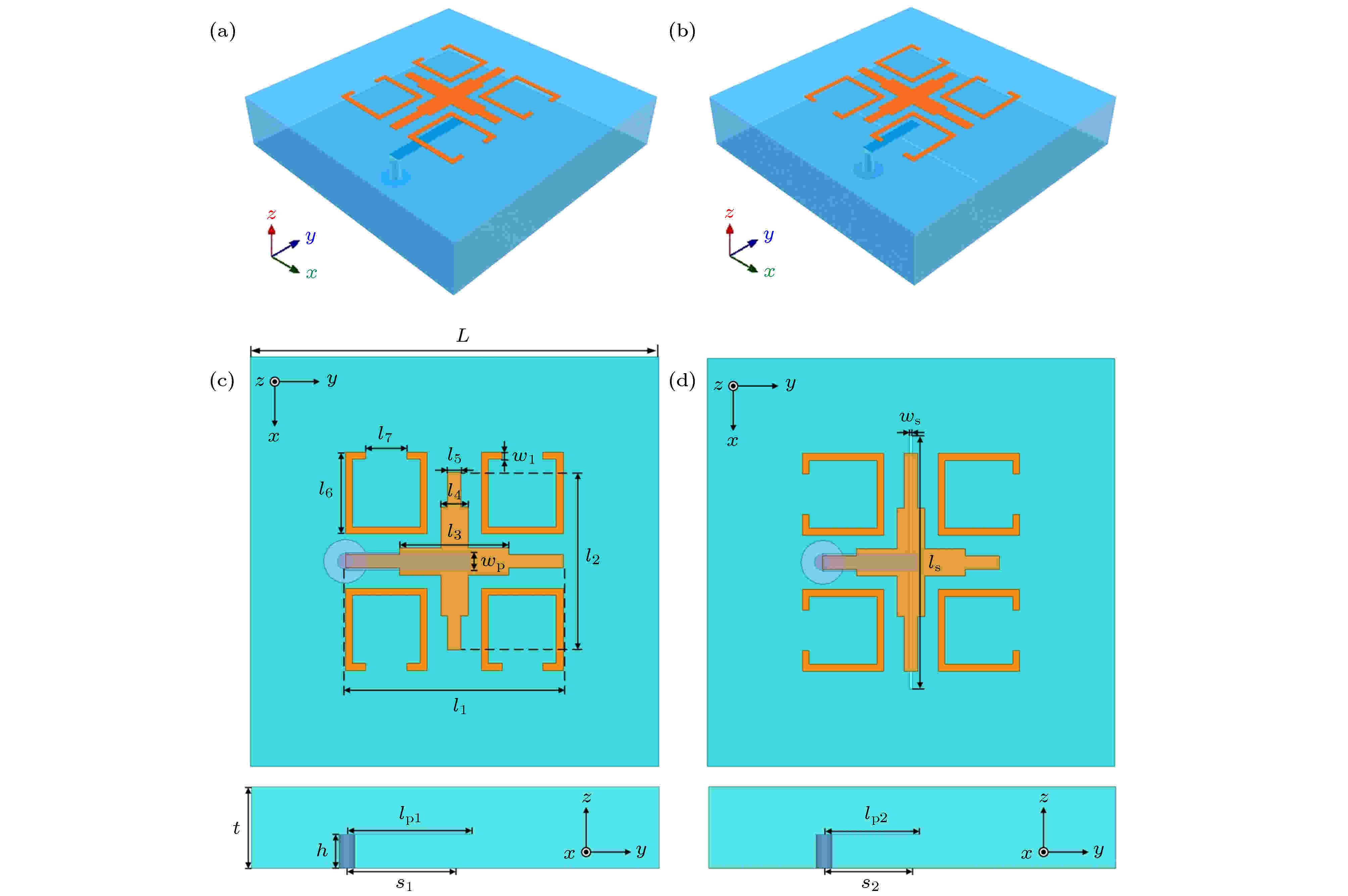
2020, 69 (24): 244101.
doi:10.7498/aps.69.20200978
Abstract +
An aperiodic metasurface antenna array with low radar cross section (RCS) is designed. The upper patches of the two antenna elements have the same shape and are placed at an orthogonal position, which can effectively reduce the workload of simulating the reflection characteristics of the patch. As antenna elements, they have identical operational band and polarization mode, and as metasurfaces, they can form an effective phase difference of 180° ± 37°. The RCS of the array is reduced mainly by phase cancellation under thexpolarization and by absorption under theypolarization. According to the coding metamaterial theory, the two elements can be coded aperiodically by using the programming software. Regarding element A and element B as “0” and “1”, respectively, the coding matrix can be solved by a genetic algorithm. Element A and element B are arranged according to positions “0” and “1” to obtain a proposed array. The scattering field of proposed array is diffusive, and the peak RCS is effectively reduced. In order to highlight the characteristics of the proposed array, the chessboard-type array is designed for comparison. The simulation results show that the radiation performance of proposed array is good. Comparing with the metal board of the same size, the 6 dB reduction bandwidth of the monostatic RCS is 4.8-7.4 GHz (relative bandwidth is 42.6%) under thexpolarization and 4.6-7.8 GHz (relative bandwidth is 51.6%) under theypolarization. Comparing with the chessboard type array, the scattering energy distribution of the designed antenna array is very uniform and the peak RCS in space reduces obviously. When a 4.8 GHz electromagnetic wave is incident with different incident angles and polarization modes, the scattering field is diffusive. Compared with other similar arrays, the proposed array has advantages of simple design process and even scattering field. The experimental results are in good agreement with the simulation results. This work makes full use of the scattering characteristics of the antenna element itself to solve the problem that the array antenna possesses both good radiation characteristics and low scattering characteristics at the same time, and improves the design process of the antenna patch. This design method has certain universality and reference significance for designing the low RCS antenna array.
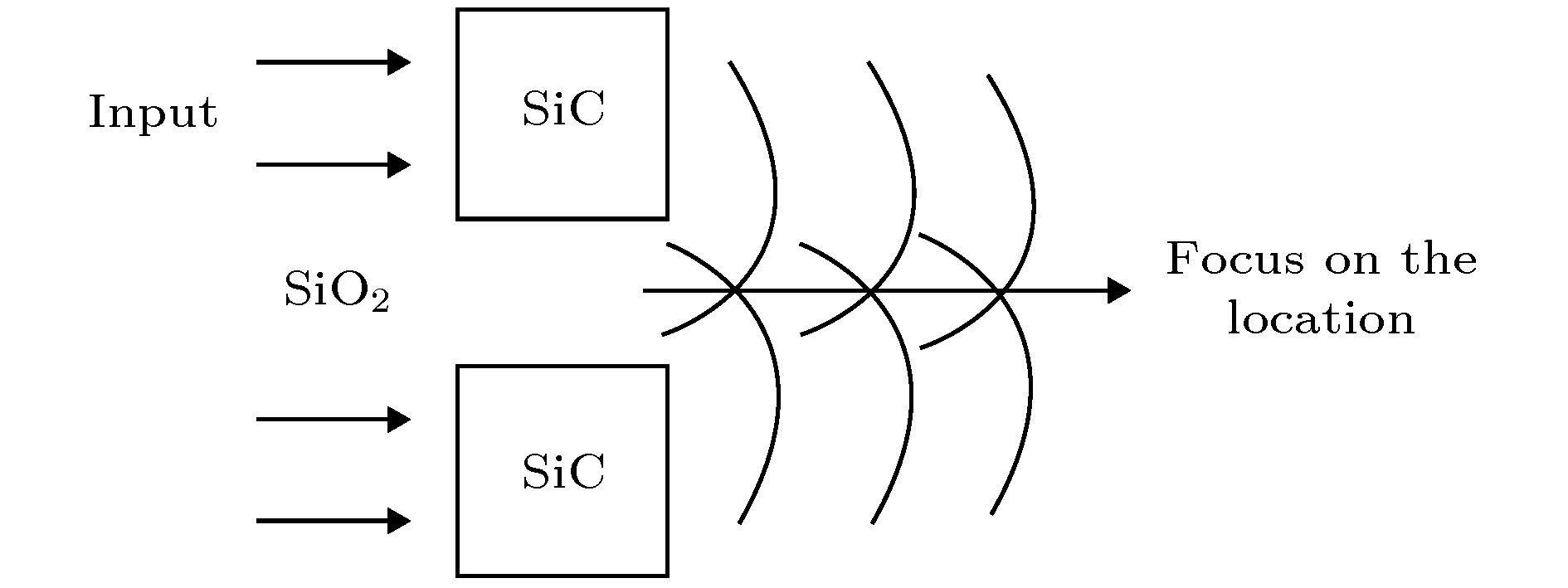
2020, 69 (24): 244201.
doi:10.7498/aps.69.20200948
Abstract +
As a basic optical element, optical lens is widely used for realizing the focusing, imaging and optical communication systems. Light of different wavelengths will propagate at different speeds. A beam of polychromatic light will produce chromatic dispersion after passing through a single optical device, which prevents the ordinary lenses from focusing the light of different wavelengths into a point. This means that the light of different wavelengths cannot be focused ideally. Traditional focusing systems can solve this problem by superimposing multiple lenses, but this is at the expense of increasing the complexity, weight, and cost of the system, and is not suitable for highly integrated nano-optical systems. At present, a better solution is to use the plane metalens, that is, using the metasurface to control the amplitude, phase and polarization at each point in space. However, the plane metalens is difficult to directly integrate on the chip. An intelligent algorithm developed by combining finite element method with genetic algorithm is used to optimize the design of multi-channel on-chip wavelength router devices and polarization router devices. In this paper, combining with years’ research results of the theory of multiple scattering coherent superposition of disordered media, the use of intelligent algorithm to design an on-chip integrated nano-lens that can achieve efficient focusing from the visible to the near infrared band. In the lens structure SiO2serves as a substrate, and the arrangement structure of SiC rectangular column is designed. The substrate size is only 2 μm × 2 μm. The lens achieves low-dispersion focusing in the band from 470 nm to 1734 nm, with a focusing efficiency of over 55% at the highest level and 30% at the lowest level, and an average focusing efficiency of 42.1%. A 200-nm waveguide is added behind the focusing region. After refocusing through the waveguide, the laser beam with a size of 2 μm can be focused by the coupling of the lens and the waveguide into a beam below 200 nm in size. The focusing efficiency goes up to 80%. At the same time, the intelligent algorithm can be applied to different types of structures. The focusing lens structures composed of triangle, diamond, or circular nano columns are designed, which can achieve an approximate focusing effect and efficient coupling propagation efficiency. This work provides important ideas for developing broadband and efficient focusing nano-lens, as well as a new way to achieve the high-density integrated nanophotonic devices.

2020, 69 (24): 244202.
doi:10.7498/aps.69.20200920
Abstract +
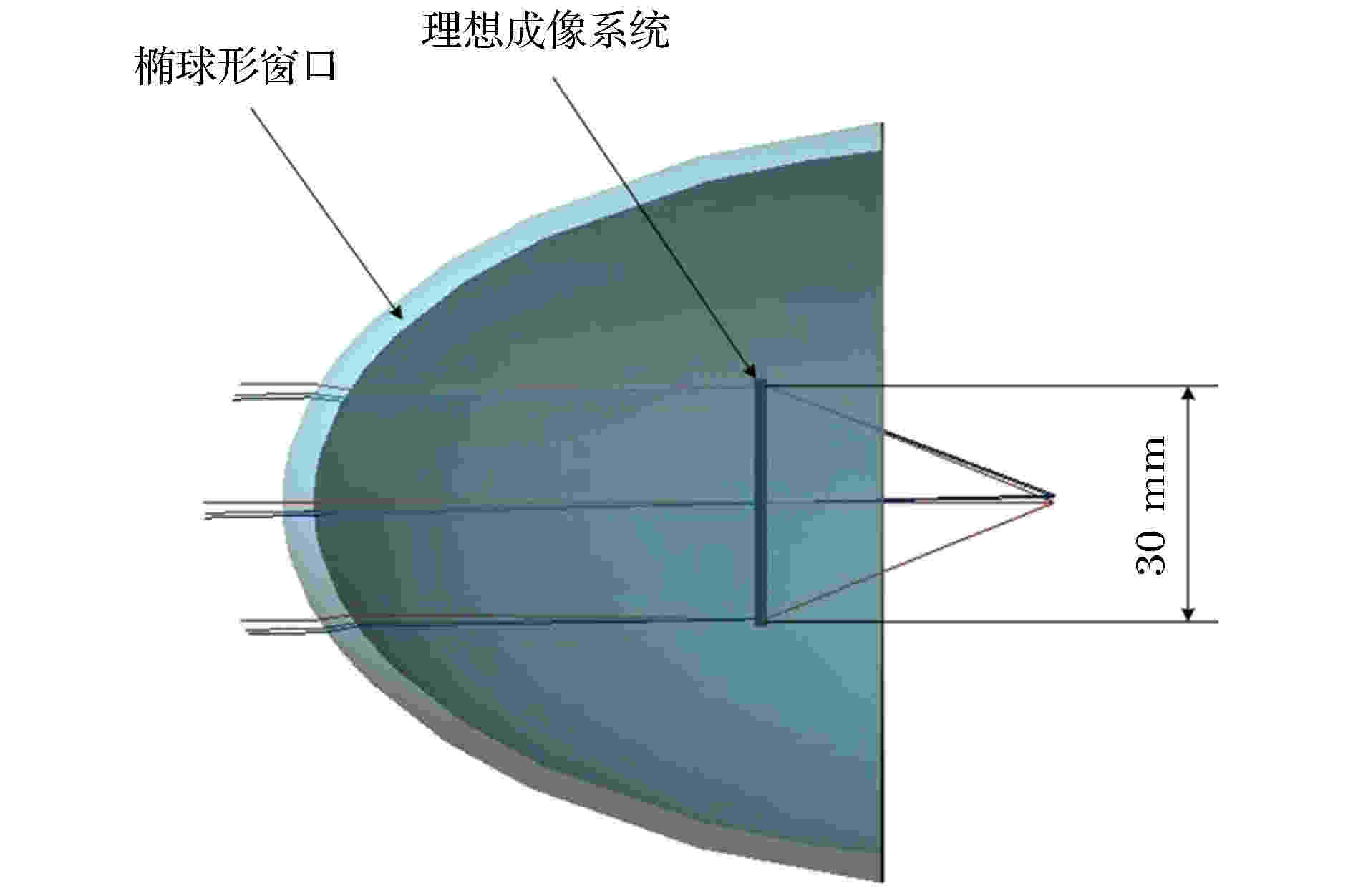
2020, 69 (24): 244203.
doi:10.7498/aps.69.20200933
Abstract +
The traditional window of high-speed aircraft is hemispherical, and the aberration produced by such a window is constant. However, the hemispherical window is difficult to meet the requirements of a high speed flight of aircraft. Aspheric windows are usually used to replace hemispherical windows to increase the aerodynamic performance. However, the aspheric window will introduce dynamic aberrations that fluctuate with the change of scanning field-of-view (FOV), which becomes the key issue of the development of optoelectronic imaging systems for high-speed aircraft. For the ellipsoidal window optical system with scanning FOV of ±60°, an aberration correction method in large FOV combined with the static correction and non-wavefront-sensor adaptive optical correction is studied. In the initial optical structure design, the types of system aberration are reduced and the fifth-order Zernike aberration is eliminated during initial aberration correction, thus, the number of the subsequent adaptive optimization control variables is reduced. According to the characteristics of the deformable mirror, the driving voltage of the driver is generally taken as a variable of the genetic algorithm. However, when the deformable mirror used has many units, too many variables will directly lead the optimization speed of the algorithm to greatly decrease. So, according to the aberration characteristics of the ellipsoidal optical window, using the conversion matrix between the Zernike polynomial coefficients and the voltages of the deformable mirror driver, the optimization variable is reduced from 140 driver voltages to 2−9 Zernike stripe polynomial coefficients in number. Finally, the genetic algorithm based on Zernike model is used to control the shape of the deformable mirror and correct the residual aberration. Taking 2−9 Zernike mode coefficients, 2−16 Zernike mode coefficients and 140 driver voltages as the variables of genetic algorithm respectively, the optimization generations of genetic algorithm under different variables are obtained. The simulation results show that the optimization speed of each typical scanning field of view is increased more than 95% by changing the variable from 140 driver voltages to 2−9 Zernike mode coefficients, and the imaging quality is close to the diffraction limit. This optimization method can not only correct the aberrations caused by the special-shaped optical window, but also compensate for the error caused by processing and aligning the optical system.

2020, 69 (24): 244204.
doi:10.7498/aps.69.20200805
Abstract +
There is serious noise interference in the decryption process of the joint transform correlator (JTC) optical encryption system, so the quality of the decrypted image cannot meet the accuracy requirements in most cases. The quality of decrypted image can be improved to a certain extent when the phase key is designed by the Gerchberg-Saxton algorithm and the iterative algorithm fuzzy control algorithm, but the complexity of the design process is inevitable and the quality of the decrypted image still needs improving. Recently, the in depth learning technology has attracted the attention of scholars in the fields of computer vision, natural language processing and optical information processing. In order to deal with the noise interference in the JTC optical encryption system, combining the current deep learning method, in this paper we propose a new denoising method for JTC optical image encryption system based on in depth learning, the dense modules are added into the generated network to enhance the reuse of feature information and improve the performance of the network. The latest self-attention mechanism area is added into the network to distinguish the weights of different channels and learn the relationship between channel and channel, so that the network can selectively strengthen the useful feature information but suppress useless feature information. The density module and the channel attention module are integrated into a DCAB synthesis module, which can effectively extract the image feature information and improve the performance of the network. The receptive field of the convolution kernel is enlarged by two down-sampling and the feature map is restored to its original size by two up-sampling. The VGG-19 is used to extract high-frequency details and texture features of images, meanwhile, the non-adversarial loss and mean-square error (MSE) loss are added into the loss function to reduce the difference among the image samples. The quality of noise-reduced images in this method are obviously better than that of the existing denoising algorithms by evaluating intuitive visual observation or SSIM (structural similarity), PSNR (peak signal to noise ratio) and MSE. The results of numerical calculation and simulation experiments show that this method can greatly eliminate the influence of noise on the JTC optical image encryption system, and effectively improve the effectiveness and feasibility of JTC optical image encryption system for high-quality image encryption.
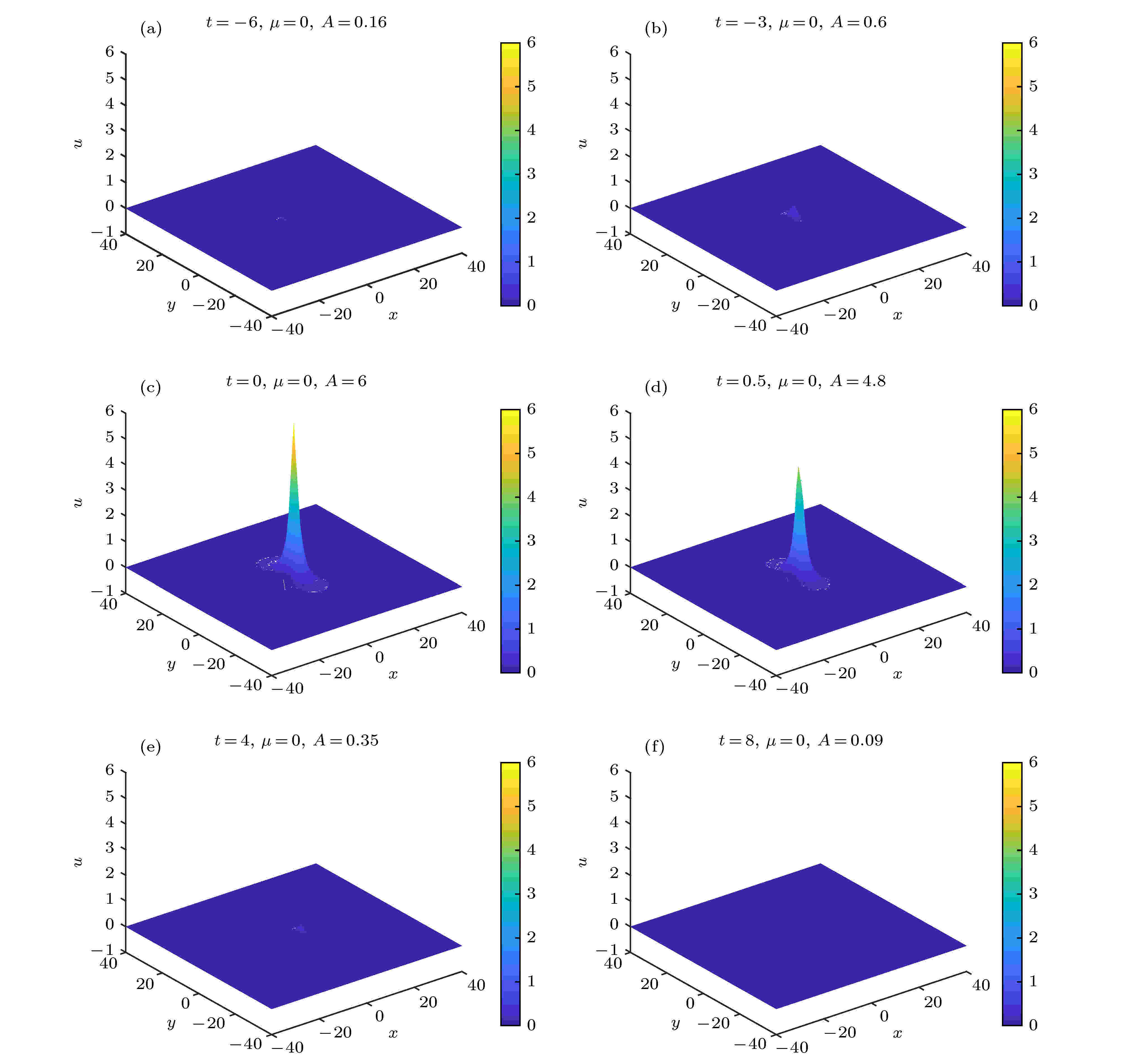
2020, 69 (24): 244205.
doi:10.7498/aps.69.20200981
Abstract +

2020, 69 (24): 244601.
doi:10.7498/aps.69.20200850
Abstract +
According to the conformal mapping from the exterior region of the regularn-polygon hole to the exterior region of a unit circle and from the exterior region of four cracks emanating from a circle to the interior region of a unit circle, a new conformal mapping is constructed to map the exterior region of four cracks emanating from a regular 4n-polygon hole to the interior of a unit circle. Then, based on the Gurtin-Murdoch surface/interface model and complex method, the anti-plane fracture of four nano-cracks emanating from a regular 4n-polygon nano-hole in magnetoelectroelastic material is studied. The exact solutions of stress intensity factor, electric displacement intensity factor, magnetic induction intensity factor, and energy release rate are obtained under the boundary condition of magnetoelectrically impermeable with considering the surface effect. Without considering the effect of the surface effect, the exact solution of four cracks emanating from a regular 4n-polygon hole in a magnetoelectroelastic material can be obtained. The numerical results show the influences of surface effect and the size of defect on the stress intensity factor, electric displacement intensity factor, magnetic induction intensity factor and energy release rate under the magnetoelectrically impermeable boundary condition. It can be seen that the stress intensity factor, electric displacement intensity factor, and magnetic induction intensity factor are significantly size-dependent when considering the surface effects of the nanoscale defects. And when the size of defect increases to a certain extent, the influence of surface effect begins to decrease and finally tends to follow the classical elasticity theory. When the distance between the center and the vertex of the regular 4n-polygon nano-hole is constant, the dimensionless field intensity factor decreases gradually with the increase of the number of edges, and approaches to the conclusion of a circular hole with four cracks. With the increase of the relative size of the crack, the dimensionless field intensity factor increases gradually. The dimensionless energy release rate of the nanoscale cracked hole has a significant size effect. The increase of mechanical load will increase the normalized energy release rate. The normalized energy release rate first decreases and then increases with electrical load increasing. The normalized energy release rate decreases with magnetic load increasing.
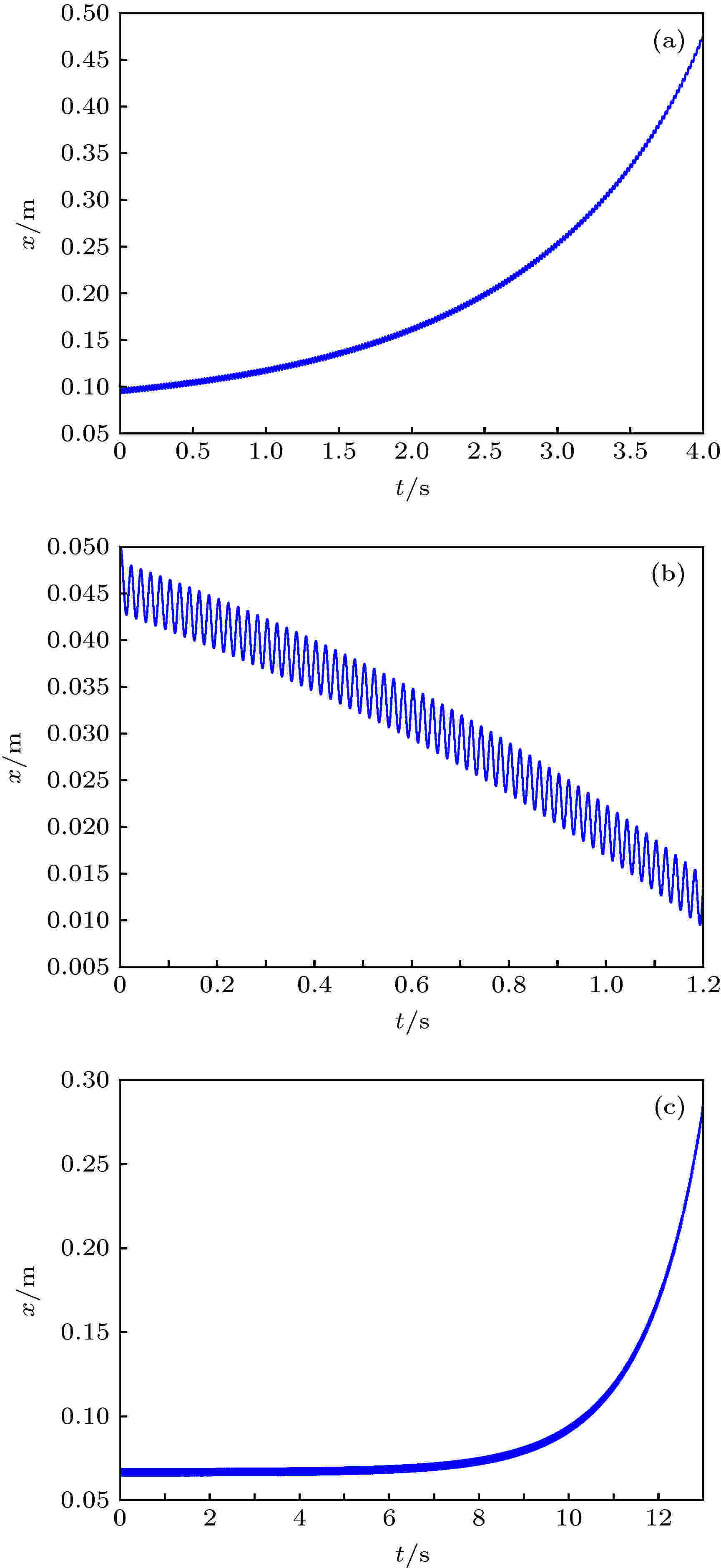
2020, 69 (24): 244602.
doi:10.7498/aps.69.20200571
Abstract +
When a container filled with water is subjected to vertical vibration, bubbles in the water may sink. This phenomenon exists widely in the field of engineering, and has a non-negligible influence on aerospace engineering and ship engineering. Therefore, it is of great significance to study the movement of bubble sinking in order to reduce the adverse effect caused by bubble sinking in the project. In previous papers, the effect of Basset force on bubble motion was usually ignored. In this paper, the bubble motion model based on the ideal gas equation is built for spherical bubbles, and the influence of the Basset force on the bubble motion is considered in the model. In the process of solving Basset force, the motion is directly separated and the convergence factor is introduced in theoretical solution. The equal step composite trapezoid formula is applied to the numerical solution. The results of numerical calculation show that the added mass force is important for bubble sinking. We find that the Basset force has no effect on the stable oscillation position of bubble, but it can accelerate the later trajectory of bubble motion. Importantly, we demonstrate that the bubble is hindered by the following component forces: buoyancy, viscous resistance, and flow thrust (which are ordered from large to small value). The movement of the bubble is observed to be in the form of oscillation, and there exists a depth, i.e. a critical depth: the bubble oscillate steadily at this depth, specifically, the bubble rises above this depth and sinks below this depth. When the vibration pressure changes, the location of the bubble’s stable oscillation will also be affected. The origin can be ascribed to the change of added mass force caused by the change of vibration pressure. Meanwhile, on the basis of digital image processing method, denoising, filtering, local stretching, image binarization and image filling are used to extract the characteristic dimension of bubbles. The theoretical value of the critical depth of bubble sinking matches the experimental result and their relative error is less than 5%. These new findings enrich the understanding of the moving bubbles in liquid materials used in nuclear reactors, rocket propulsion fuels and chemical experiments.
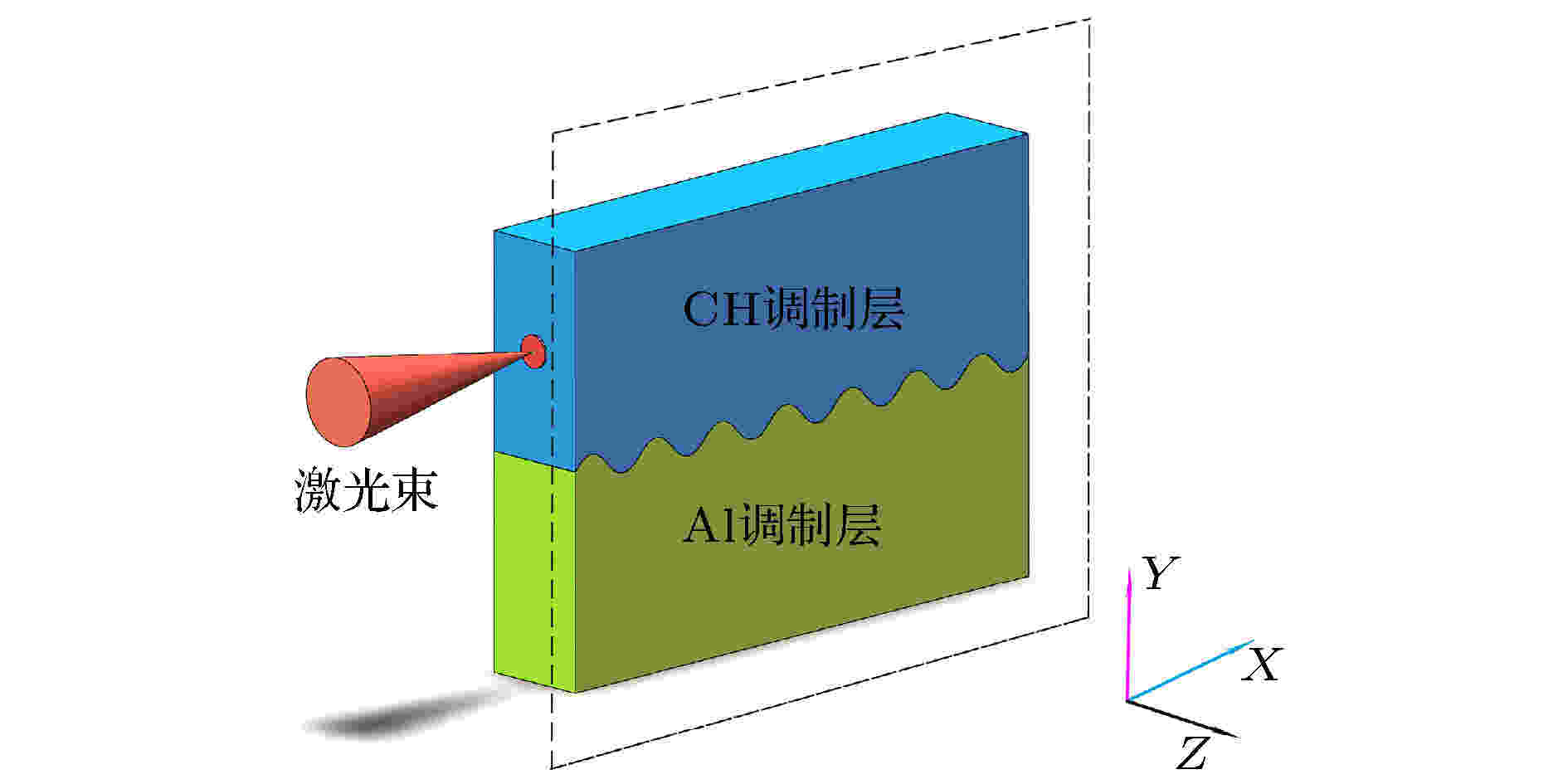
2020, 69 (24): 244701.
doi:10.7498/aps.69.20201167
Abstract +
Kelvin-Helmholtz instability is the basic physical process of fluids and plasmas. It is widely present in natural, astrophysical, and high energy density physical phenomena. With the construction of strong laser facilities, the research on high energy density physics has gained new impetus. However, in recent years the magnetized Kelvin-Helmholtz instability was rarely studied experimentally. In this work, we propose a new experimental scheme, in which a long-pulsed nanosecond laser beam is generated by a domestic starlight III laser facility. The whole target consists of two parts: the upper part that is the CH modulation layer with lower density, and the lower part that is the Al modulation layer with higher density. The laser beam is injected from one side of the CH modulation layer and generates a CH plasma outflow at the back of the target. During the transmission of the CH plasma outflow, the Al modulation layer is radiated and ionized, which makes the Al modulation layer generate an Al plasma outflow. The interaction between the Al plasma outflow and the CH plasma outflow produces a velocity shear layer, and then Kelvin-Helmholtz instability will gradually form near the Al modulation layer. In this paper, the open-source FLASH simulation program is used to conduct a two-dimensional numerical simulation of the Kelvin-Helmholtz instability generated by the laser-driven modulation target. We use the FLASH code, which is an adaptive mesh refinement program, developed by the Flash Center at the University of Chicago, and is well-known in astrophysics and space geophysics, to create a reference to the magnetohydrodynamic solution in our experiment. At present, this code introduces a complete high-energy-density physical modeling module, which is especially suitable for simulating intense laser ablation experiments. The equation of state and opacity tables of targets are based on the IONMIX4 database. The evolution of Kelvin-Helmholtz vortices, separately, in the Biermann self-generated magnetic field, the external magnetic field, and no magnetic field are investigated and compared with each other. It is found that the self-generated magnetic field hardly changes the morphology of the Kelvin-Helmholtz vortex during the evolution of Kelvin-Helmholtz instability. The external magnetic field parallel to the fluid direction can stabilize the shear flow. The magnetic field mainly stabilizes the long wave disturbance. The study results in this work can provide theoretical guidance for the next step of the Kelvin-Helmholtz experiment under a strong magnetic environment in the high energy density laser facility.
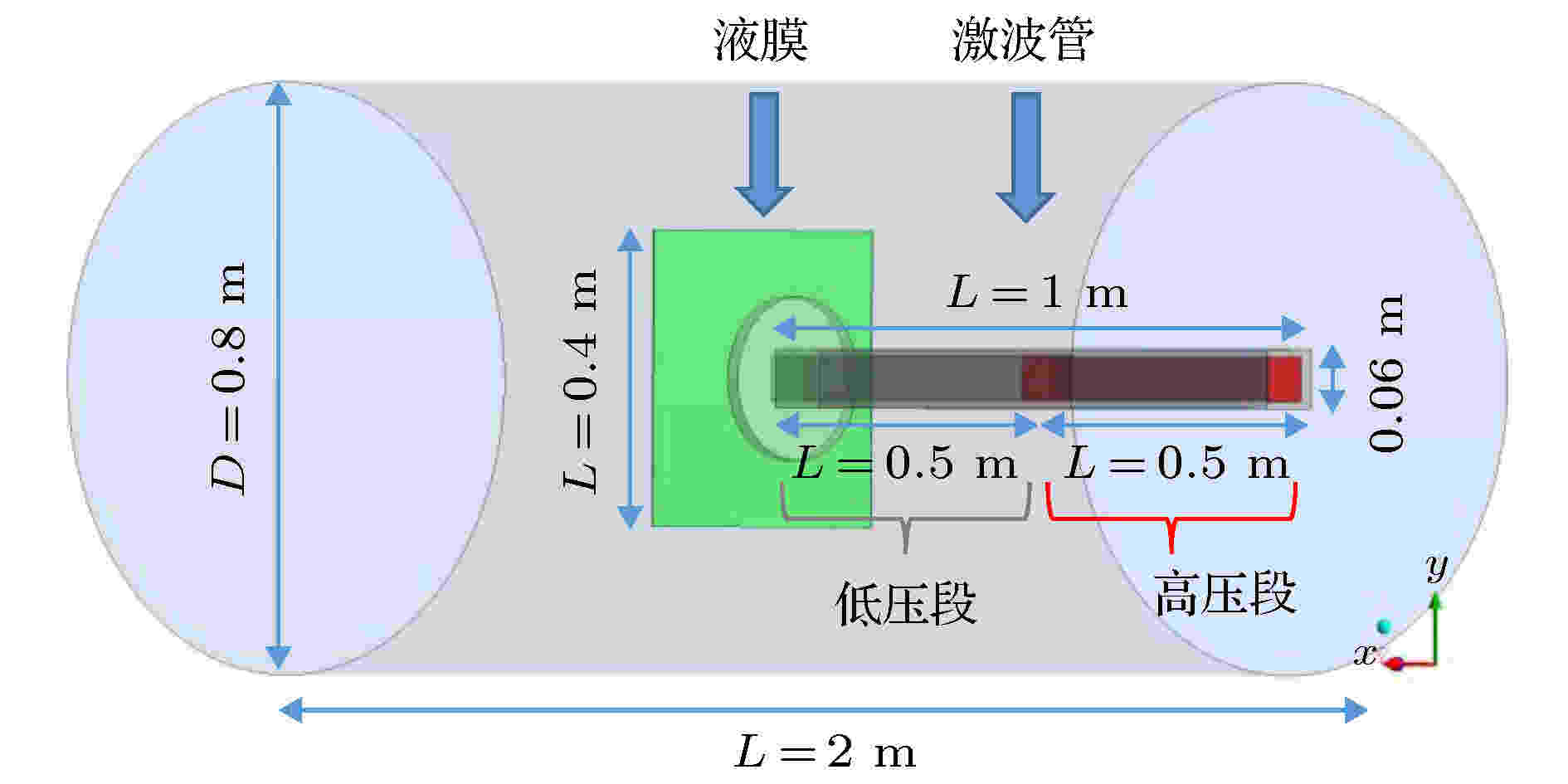
2020, 69 (24): 244702.
doi:10.7498/aps.69.20201051
Abstract +
The gas-liquid two-phase flow of liquid dispersing and breaking under the action of shock wave includes complex physical phenomena, such as turbulent mixing of gas-liquid two-phase, instability and breakage of liquid interface, and formation of internal cavity structure after atomization. In order to investigate the shock-wave-caused breaking process of the liquid film, a three-dimensional numerical simulation of the gas-liquid two-phase flow process is performed by using the computational fluid dynamics method. In the simulation, the Mach number of shock wave is 1.5 and the thickness of liquid film is 2 mm. The finite volume method is used to solve the three-dimensional Navier-Stokes equation. The volume of fluid model is applied to the gas-liquid two-phase flow. Thek-εdouble equation turbulence model is selected for the turbulence calculation. The evolution process of the wave system structure of the shock wave and the deformation, breakage and atomization characteristics of the liquid film are obtained, and compared with the experimental results. The results show that the incidence, reflection, and transmission phenomena occur during the interaction between the shock wave and the liquid film, and the intensity of the transmitted shock wave and the liquid surface tension have an important effect on the breaking process of the liquid film. The transmitted shock wave affects the shape of the broken cloud cluster on the left of the liquid film, while the incident shock wave and reflected shock wave affect the shape of the broken cloud cluster on the right side of the liquid film. The volume of the atomized cloud formed in the breaking process of the liquid film increases rapidly, first reaching 6.7 dm3within 2.5 ms, then keeping stable basically. After the shock wave exits from the tube, a long narrow jet is formed. The maximum velocity reaches 519 m/s and appears in the interior of the jet, and then decreases continuously. Under the action of the jet, an expanding three-dimensional cavity structure is formed inside the atomizing cloud, and an annular vortex with negative pressure in the core area occurs in the cavity structure. Finally, the annular vortex continuously entrains the surrounding fluid in the process of forward movement, the strength of the vortex decreases and gradually dissipates in the space. This work is conducive to further understanding the interaction process of gas-liquid two-phase flow.
CONDENSED MATTER: STRUCTURAL, MECHANICAL, AND THERMAL PROPERTIES
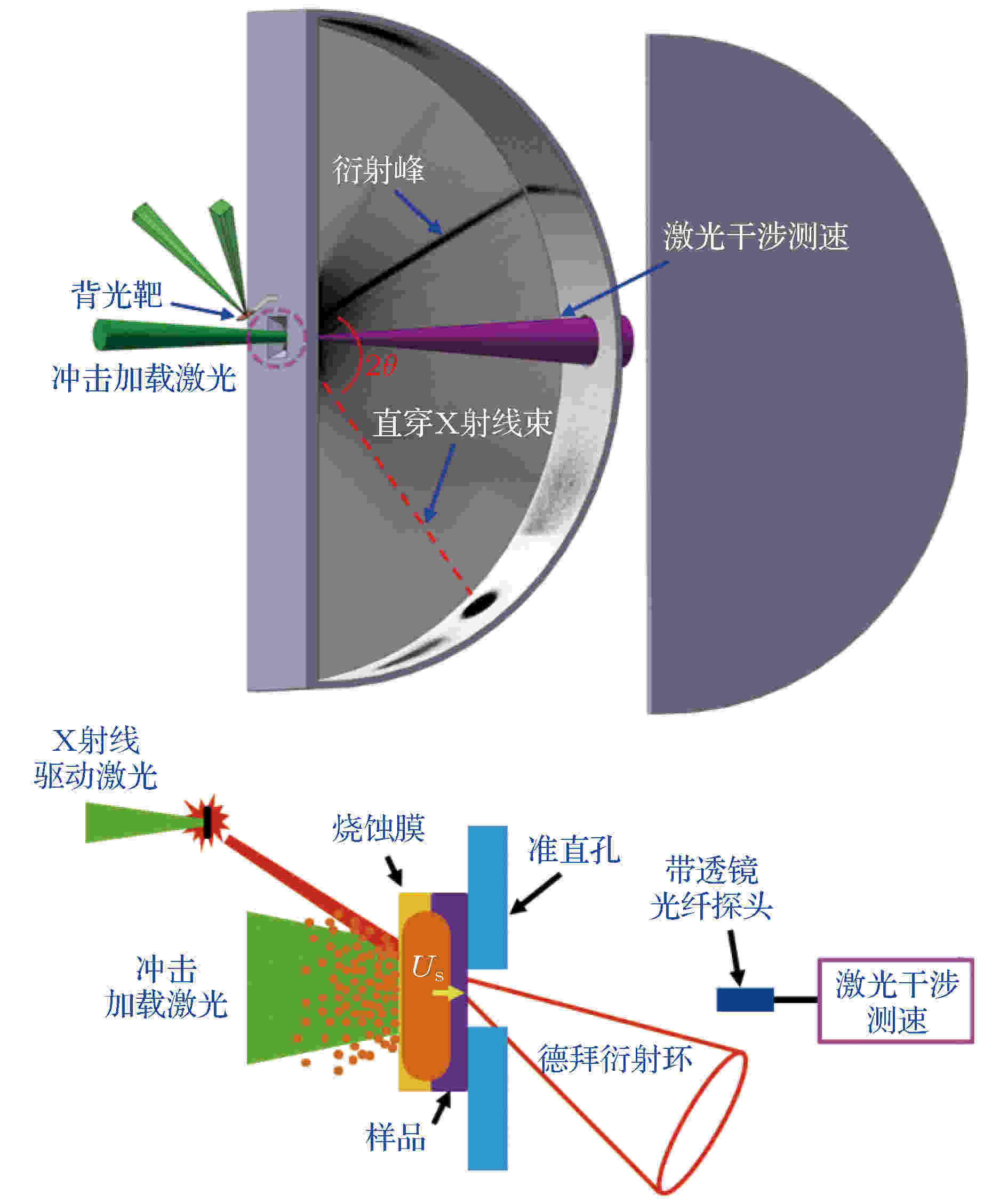
EDITOR'S SUGGESTION
2020, 69 (24): 246201.
doi:10.7498/aps.69.20200929
Abstract +
The knowledge of phase transition of material under dynamic loading is an important area of research in inertial confinement fusion and material science. Though the shock-induced phase transitions of various materials over a broad pressure range have become a field of study for decades, the loading strain rates in most of these experiments is not more than
$ {10^{6}}\;{{\rm{s}}^{ - 1}} $
. However, in contrast with the strain rate range where the phase diagram is a good predictor of the crystal structure of a material, at higher strain rate (
$ > {10^{6}}\;{{\rm{s}}^{ - 1}} $
) the phase diagram measured can be quite different not only in shifting the boundary line between various phases, but also in giving a different sequence of crystal structure. High-power laser facility can drive shock wave and simultaneously provide a precisely synchronized ultra-short and ultra-intense X-ray source. Here, based on the Prototype laser facility, anin situX-ray diffraction platform for diagnosing shock-induced phase transition of polycrystalline material is established. Thein situobservation of material phase transition under high-strain-rate shock loading is carried out with typical metals of vanadium and iron. Diffraction results are consistent with vanadium remaining in the body-centered-cubic structure up to 69 GPa, while iron transforms from the body-centered-cubic structure into hexagonal-close-packed structure at 159 GPa. The compressive properties of vanadium and iron obtained inin situX-ray diffraction experiment are in good agreement with their macroscopic Hugonoit curves. The decrease in the lattice volume over the pressure step period yields a strain rate on the order of
$ {10^{8}} - {10^{9}}\;{{\rm{s}}^{ - 1}} $
. The available of the presentedin situX-ray diffraction plateform offers the potential to extend our understanding of the kinetics of phase transition in polycrystalline under high-pressure high-strain-rate shock compression.
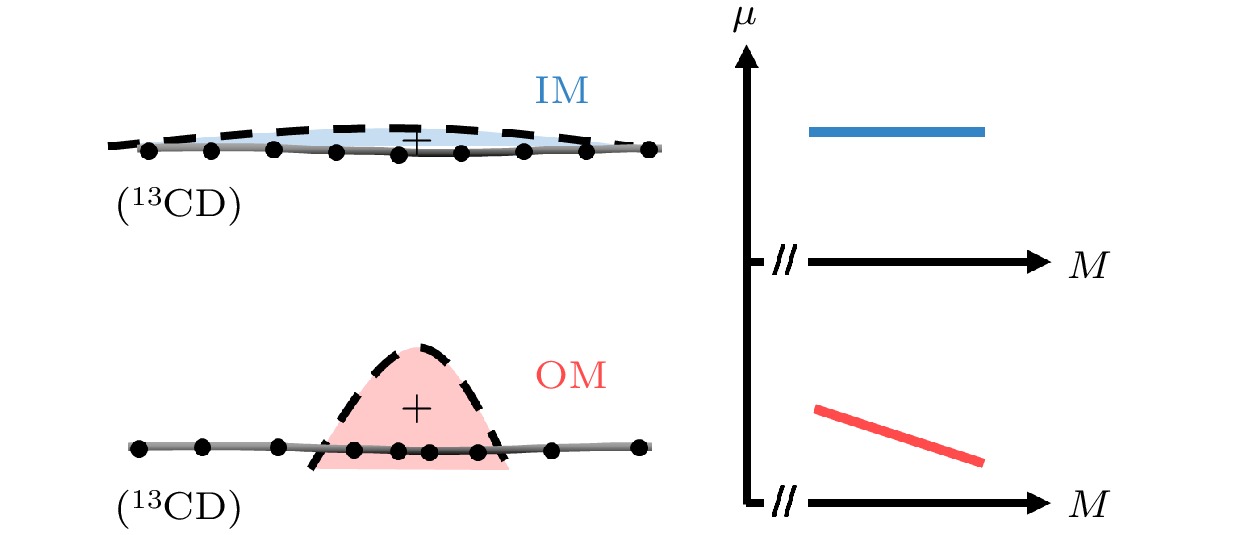
2020, 69 (24): 246701.
doi:10.7498/aps.69.20200789
Abstract +
Isotopic substitution can effectively tune the device performances of organic semiconductors. According to the experimental results of isotope effects in electric, light and magnetic process in organic semiconductors, we adopt the tight-binding model with strong electron-phonon coupling to study the isotope effects on carrier transport. We try to give a quantificational explanation and show the physical origin of isotope effects on mobility in organic semiconductors in this work. Using polaron transport dynamics with diabatic approach, we simulate the carrier transport in an array of small molecule crystals under weak bias. Because of strong electron-phonon coupling in organic materials, an injected electron will induce lattice distortion, and the carriers are no longer free electrons or holes, but elementary excitations such as solitons, polarons or bipolarons. Our simulation results indicate that the existence of deuterium and13C element will reduce the mobility of organic material, which means that the isotopic substitution can be utilized to manifest organic device performance. Besides, we also find that the isotope effect on mobility will increase with electron-phonon coupling increasing. This suggests that both the mass of lattice groups and electron-phonon coupling should be taken into account to understand the isotope effects in organic semiconductors. With the consideration of that, we derive the effective mass of polaron based on the continuum model, and verify that effective mass can successfully describe the isotope effect on mobility. The effective mass of carrier can be measured to represent the property of a material, which can tell us whether we need the isotopic substitution in organic layer to improve the device performance. Then we present the microcosmic movement of a polaron at the moment when it encounters isotopic substituted molecules. We come to the conclusion that the isotopic distribution will affect the instantaneous speed of the carrier, but has little effect on the mobility of the whole device when the substituted concentration remains constant. In conclusion, after simulating various possible isotope effects in materials, analyzing its physical mechanism and comparing calculation results in experiment, we provide a theoretical foundation for describing the isotope effects on mobility, which can be a basis of improving the performances of organic semiconductor devices.
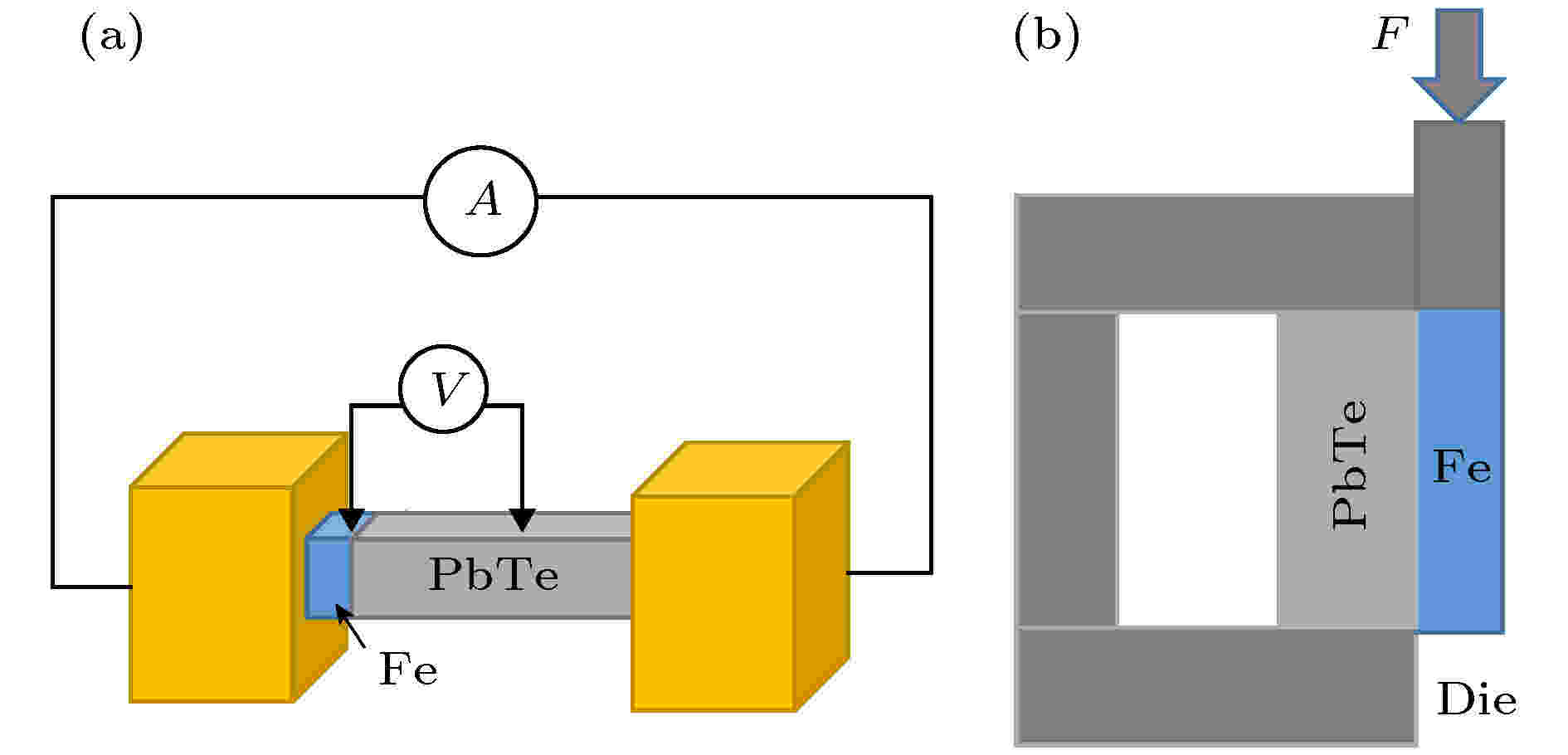
2020, 69 (24): 246801.
doi:10.7498/aps.69.20201080
Abstract +
The conversion efficiency of thermoelectric material PbTe is high. A high-quality and high-conversion-efficiency PbTe thermoelectric connector is investigated systematically. Excess Pb in composition can increase the carrier concentration and improve the thermoelectric performance of PbTe. The composite electrode can improve the interface barrier and reduce the contact resistance. Traditional processes of making contacts onto bulk crystalline PbTe-based materials do not work for reducing the contact resistance by inhibiting element diffusion and increasing the shear strength at the same time. In this study, we consider a composite electrode which can form an intermediate layer to suppress the diffusion of the Pb element on the PbTe side. This work not only reduces the contact resistance, but also increases the shear strength. The sample Pb50.01Te49.99is obtained by adjusting the stoichiometric ratio of PbTe; Te and Pb are mixed in the Fe electrode. The composite electrode and Pb50.01Te49.99are hot-pressed and sintered in one step to obtain the required PbTe thermoelectric electrode joint. We find that the contact resistance of the composite electrode is reduced by nearly 75% compared with that of metallization layer (Fe) connection. The smallest value is 26.610 μΩ·cm2which is closer to the lowest 10 μΩ·cm2reported in the literature than the counterpart of pure Fe electrode, and the shear strength is also greatly improved simultaneously. This work provides a new idea for obtaining PbTe thermoelectric connectors with excellent performance.

2020, 69 (24): 246802.
doi:10.7498/aps.69.20201231
Abstract +
One-dimensional (1D) carbyne chain has the potential applications in the nanoelectronic devices due to its unique properties. Although some progress of the mechanical and thermal properties of 1D carbyne chain has been made, the physical mechanism of the strain modulation of atomic bond nature remains unclear. In order to explore the strain effects on the mechanical and related physical properties of 1D carbyne chain, we systematically investigate the strain-dependent bond nature of 1D carbyne chain based on the first-principles calculations of density functional theory and generalized gradient approximation. It is found that when the compressive strain is 16%, the bonding nature of 1D carbyne chain is changed, and the bond length alternation of single and triple bonds in 1D carbyne chain tends to zero, which originates from the difference in bond strength between single bond and triple bond. Moreover, 1D carbyne chain can change from semiconductor into metal when the compressive strain is 16% indicated by analyzing the band structure and related differential charge density. When the strain is 17%, the phonon spectrum has an imaginary frequency. Besides, when the ambient temperature is less than 510 K, the heat capacity of 1D carbyne chain decreases with strain increasing. However, more phonon modes will be activated at larger strains when the temperature is higher than 510 K, and the heat capacity is enhanced gradually with strain increasing. Also, the stiffness coefficient of 1D carbyne chain is larger than that of graphene and carbon nanotube. These results conduce to the fundamental understanding of atomic bond nature in 1D carbyne chain under different strains.
CONDENSED MATTER: ELECTRONIC STRUCTURE, ELECTRICAL, MAGNETIC, AND OPTICAL PROPERTIES
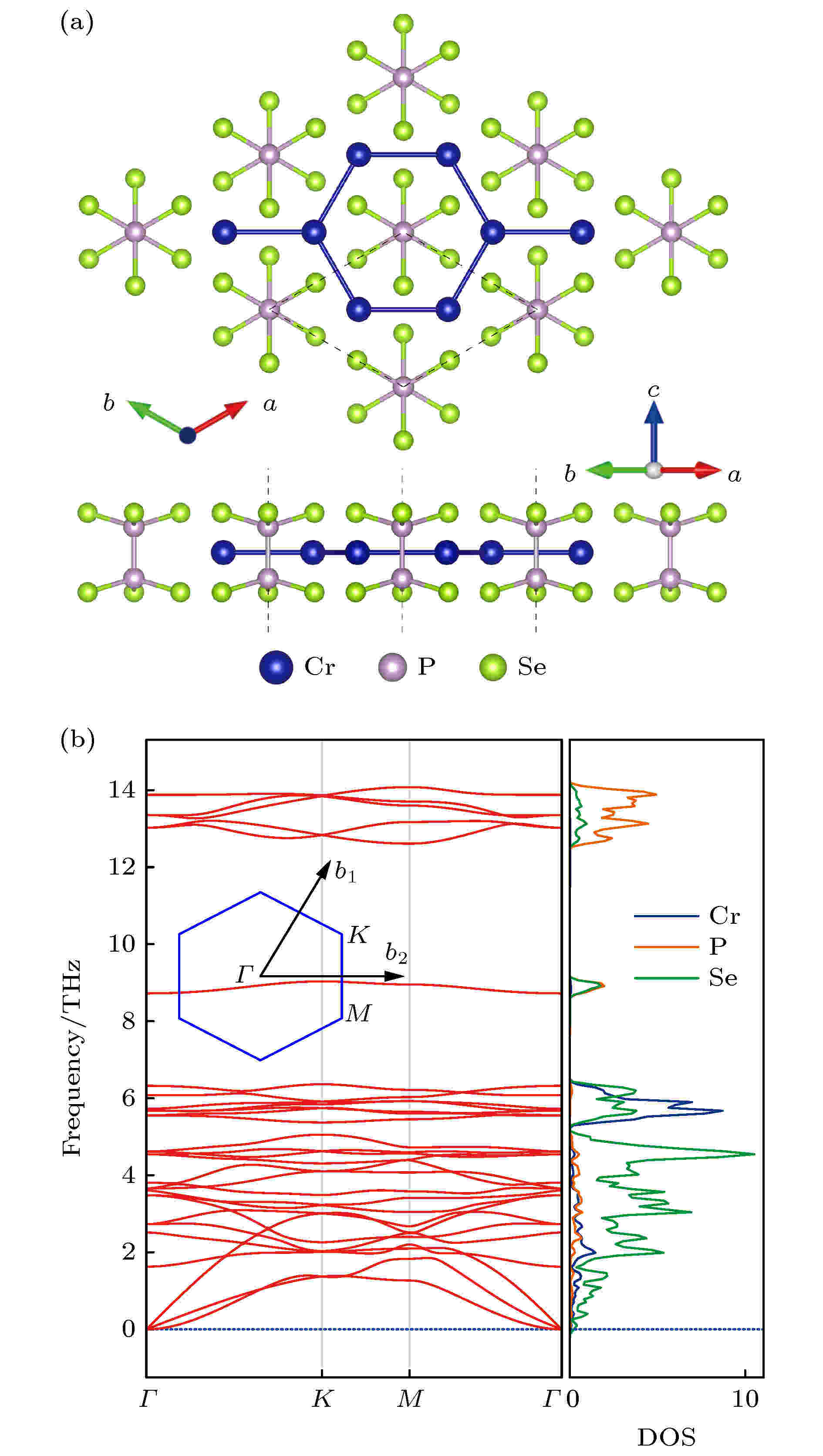
2020, 69 (24): 247101.
doi:10.7498/aps.69.20200960
Abstract +
According to the first-principles calculation within PBE+Umethod and tight-binding model, the magnetic properties and electronic structures of two-dimensional (2D) CrPSe3monolayer were investigated. Constructed by a Cr-honeycomb hexagonal lattice, 2D CrPSe3was predicted to be in a half-metallic ferromagnetic state with dynamic stability, confirmed by the phonon spectrum with no imaginary dispersion. The Curie temperature was estimated as 224 K by Monte Carlo simulation within the Metropolis algorithm under the periodic boundary condition. The thermal stability of CrPSe3monolayer was estimated at 300 K by a first-principles molecular dynamics simulation. It is found that the magnetic ground state of CrPSe3monolayer is determined by a competition between the antiferomagnetic d-d direct exchange interactions and the Se-p orbitals mediated ferromagnetic p-d superexchange interactions. Most interestingly, in the half-metallic state the band structure exhibits multiple Dirac cones in the first Brillouin zone: two cones atKpoint showing a very high Fermi velocity
${v_{\rm F}{(K)}} = 15.8 \times 10^5 \;{\rm m \!\cdot\! s^{-1}}$
about twice larger than the
$ v_{\rm F} $
of graphene in the vicinity of Fermi level, and six cones at
$ K'/2 $
points with
${ v_{\rm F} {(K'/2)}} = 10.1 \times 10^5\;{\rm m \!\cdot\! s^{-1}}$
close to the graphene's value. These spin-polarized Dirac cones are mostly composed of Cr
${\rm d}_{xz}$
and
${\rm d}_{yz}$
orbitals. The novel electronic structure of CrPSe3monolayer is also confirmed by the HSE06 functional. A tight-binding model was built based on the Cr-honeycomb structure with two Cr-d orbitals as the basic with the first, second and third nearest-neighboring interactions, further demonstrating that the multiple Dirac cones are protected by the Cr-honeycomb lattice symmetry. Our findings indicate that 2D CrPSe3monolayer is a candidate with potential applications in the low-dimensional, high speed and temperature spintronics.
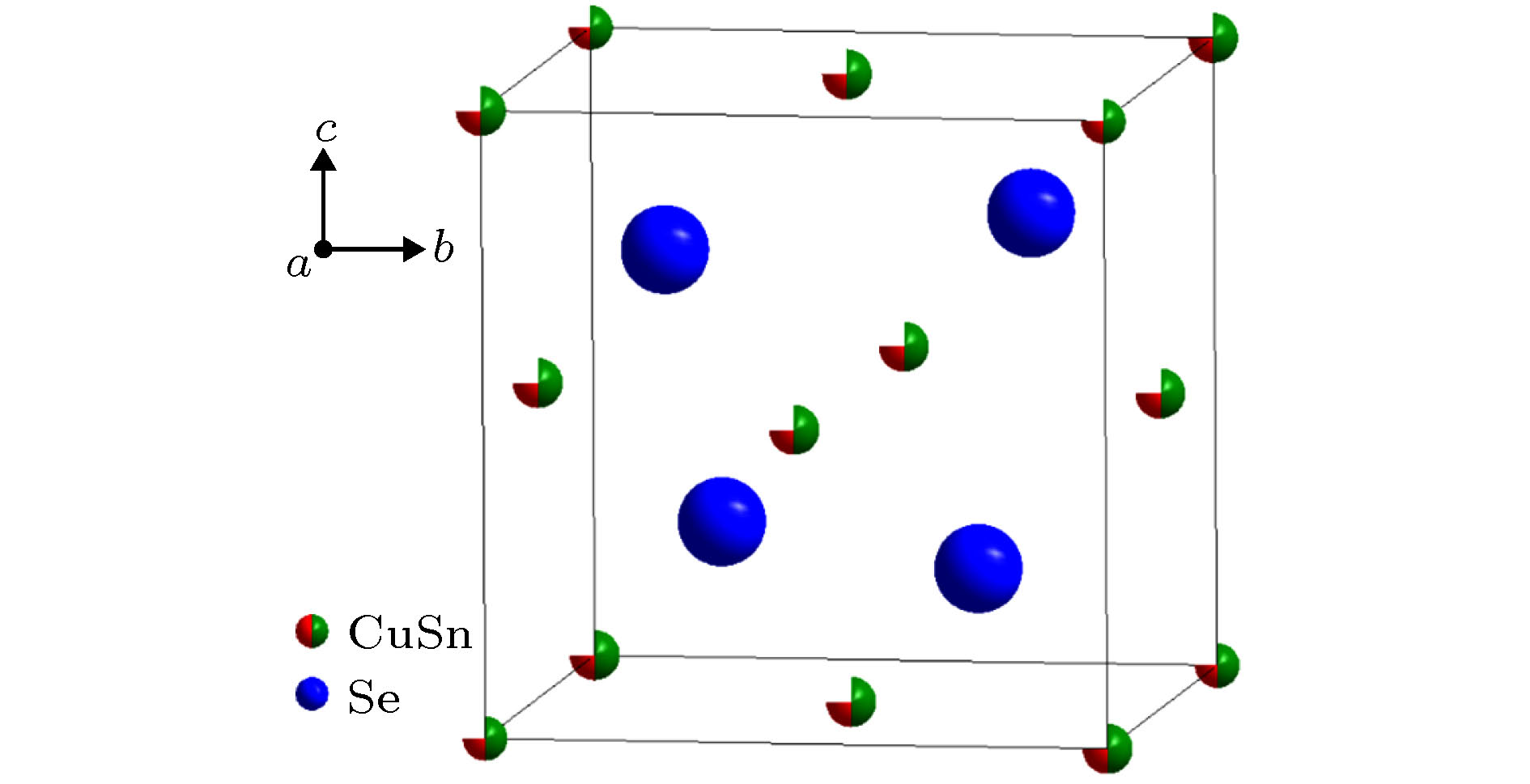
2020, 69 (24): 247102.
doi:10.7498/aps.69.20200861
Abstract +
Cu2SnSe4compound, as a non-toxic inexpensive thermoelectric material, has low thermal conductivity and adjustable conductivity, which promises to have a high-efficiency thermoelectric application in a medium-temperature range. The Cu-doped bulk samples of Cu2+xSnSe4(0 ≤x≤ 1) compounds are synthesized by a fast method, i.e. by combining high energy ball milling with spark plasma sintering. In this work, the thermoelectric properties of Cu-doped Cu2SnSe4compound are investigated. The experimental results reveal that the intrinsic vacancy at Cu/Sn site of Cu2SnSe4can be completely filled by Cu (i.e.x= 1 in Cu2+xSnSe4). The crystal structures of all Cu2+xSnSe4samples have the same space groupF3mas that of the undoped Cu2SnSe4. The electrical conductivity of Cu2+xSnSe4increases rapidly with the content of Cu doped at intrinsic vacancy increasing, concretely, it increases by two orders of magnitude and reaches a maximum value atx= 0.8. The increase in electrical conductivity results in the significant improvement in power factor. The observed results display that the increase in electrical conductivity is a nonlinear relationship with Cu-doping content in a range of 0 <x< 0.1, but is linearly related to the Cu-doping content in a range of 0.1 ≤x≤ 0.8. Meanwhile, the carrier (hole) concentration is observed to reach a maximum value atx= 0.2 and then slightly decreases atx= 0.8. The rapid increase in electrical conductivity with Cu-doping content increasing may be attributed to the intensifying of Cu-Se bond network that plays a dominant role in controlling hole transport in Cu2SnSe4. The carrier mobility also increases with the Cu-doping content increasing in the range of 0 ≤x≤ 0.8, which is in contrast to the common scenarios in thermoelectric materials that the carrier mobility decreases with the increase in the carrier concentration. Furthermore, the carrier transport mechanism of Cu2+xSnSe4sample is revealed to be able to be described by the small polaron hopping model, which means the strong coupling between electron and phonon. The analysis of thermal conductivities of the Cu2+xSnSe4samples reveals that the relationship between the electronic thermal conductivity and the electrical conductivity cannot be described by the classical Wiedemanmn-Franz law, which may be attributed to the formation of electron-phonon coupled small polaron. Therefore, the coupling between electron and phonon inside the Cu2+xSnSe4structure strongly influences the behaviors of carrier transmission and thermal conductivity.

2020, 69 (24): 247201.
doi:10.7498/aps.69.20200834
Abstract +
In this paper, the voltage induced metal-insulator phase transition (MIT) of polyethene glycol (PEG) composite film is investigated based on VO2nanoparticles prepared by the hydrothermal method and vacuum annealing process. High purity VO2(B) nanoparticles are obtained after being treated in a hydrothermal reactor at 180 ℃ for 12 h by using vanadium pentoxide (V2O5) and oxalic acid (H2C2O4·2H2O) as raw materials. The X-ray diffraction (XRD) pattern shows that the prepared nano-powders are free of impurities, and the scanning electron microscope (SEM) pictures confirm that the micro-morphology is of a band-shaped nano-structure. Next, these products are heated in a vacuum quartz tube at 500 ℃ for different times. The XRD and differential scanning calorimeter (DSC) curves of the annealed samples prove that the VO2(M) with MIT performance is successfully prepared. And the content of M phase in the sample increases with preparation time increasing. When the annealing time is longer than 60 min, all the samples are converted into materials with M phase. The SEM images show that the average length of the nano-powders decreases with the annealing time increasing from 10 min to 300 min. Then PEG coating containing VO2(M) nanoparticles is applied between two electrodes with a pitch of 1 mm on printed circuit board (PCB). TheV-Itest is carried out after a 20 kΩ resistor has been connected in the circuit. The results display repeatable non-linearV-Icurves indicating that the composite film undergoes an MIT phase transition under voltage. After it is activated for the first test, the MIT voltage and non-linear coefficient increase exponentially as the length of VO2decreases. Besides, it is also found that the voltage across the material is maintained at around 10 V after the resistance has changed suddenly, which is similar to the behavior of diode clamping voltage. We believe that the phase transition voltage and non-linear coefficient of the VO2composite film are influenced by the intra-particle potential barrier and the inter-layer potential barrier. The longer the average length of the nanoparticles, the higher the potential barrier between the interfaces in the conductive channels is, and thus increasing the phase transition voltage and phase transition coefficient. The activation phenomenon of the thin film is caused by reducing the barrier between particles during the first test. Furthermore, the results can prove that the electric field is the determinant of the phase transition during the VO2composite film electrical field induced MIT of the VO2composite film. However, after the phase transition, Joule heat plays a significant role in maintaining the low resistance state.
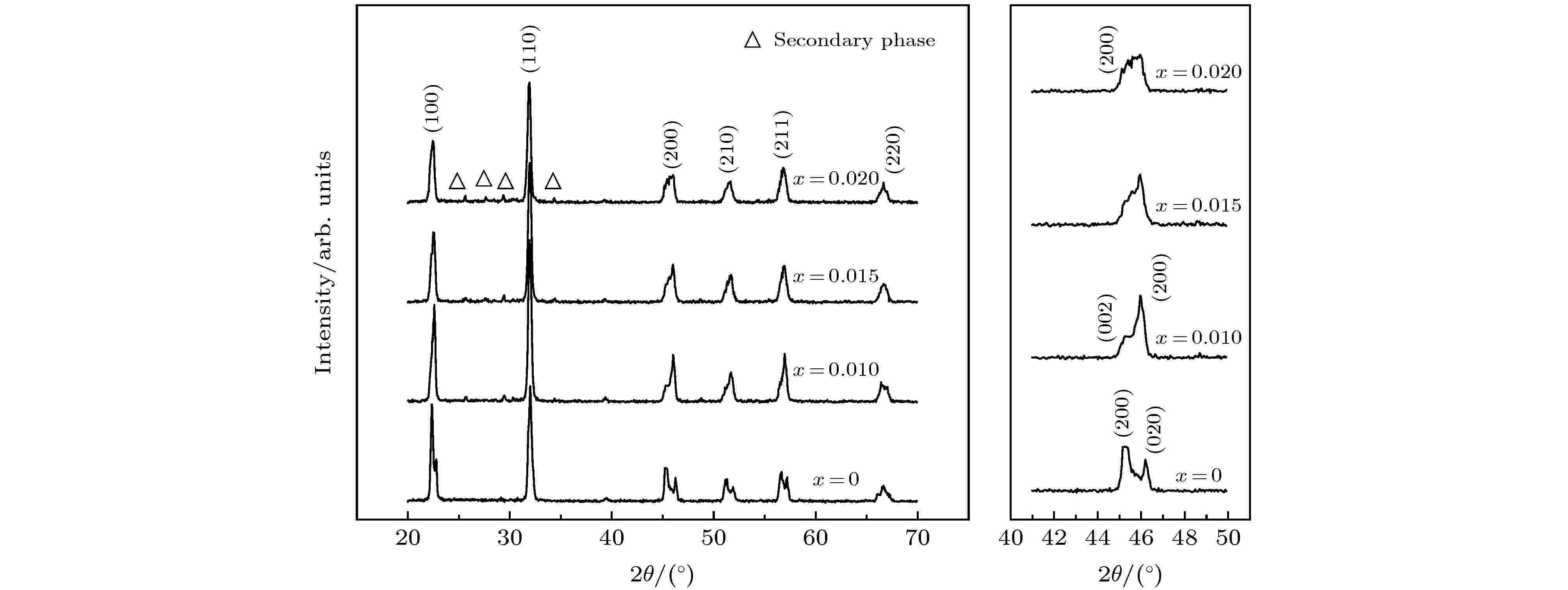
2020, 69 (24): 247702.
doi:10.7498/aps.69.20201317
Abstract +
Traditional transparent materials, including glasses and polymers, are chemically unstable and mechanically weak. Single crystals of some inorganic materials are also optically transparent, which are more stable than glasses and polymers. The fabrication of crystals, however, is relatively slow. Fortunately, transparent ceramics emerge as a promising candidate. Transparent ferroelectric ceramic is a kind of transparent ceramic with electro-optic effect, which also has excellent characteristics of conventional ceramics with excellent mechanical properties, resistance to high temperature, resistance against corrosion, and high hardness. Lead based transparent ferroelectric ceramic dominates this field for many years due to its superior electro-optic effect. Owing to the high toxicity of lead oxide, however, its development is significantly hampered. Therefore, it is greatly urgent to develop the lead-free transparent ferroelectric ceramics with excellent properties to replace the traditional lead based ceramics. In this paper, (K0.5Na0.5)0.94–3xLi0.06LaxNb0.95Ta0.05O3(KNLTN-Lax;x= 0, 0.01, 0.015, 0.02) lead-free transparent ferroelectric materials are fabricated by the conventional solid state reaction method and ordinary sintering process. The dependence of microstructure, phase structure, optical transmittance and electrical properties of the ceramic on composition are systemically investigated. The transparent ferroelectric ceramic with relaxor-behavior is obtained atx= 0.02. The optical transmittance of the ceramic near infrared region is as high as 60%. Meanwhile, the electrical properties of the ceramic atx= 0.01 still maintains a relatively high level (d33= 110 pC/N,kp= 0.267). In addition, the Curie temperature for each of all the samples is higher than 400 ℃. These results suggest that this material might be a novel and promising lead-free material that could be used in a large variety of electro-optical devices.
INTERDISCIPLINARY PHYSICS AND RELATED AREAS OF SCIENCE AND TECHNOLOGY

2020, 69 (24): 248101.
doi:10.7498/aps.69.20200956
Abstract +
It is of great significance to study the characteristics and working mechanism of NO2sensor material for monitoring air pollution and protecting human health. As a metal oxide semiconductor material with simple preparation, low cost and good long-term stability, In2O3has been widely studied in the detection of NO2. In order to explore the influence of Fe content on the gas sensing properties of porous In2O3material, porous Fe-doped In2O3nanoparticles are synthesized by the hydrothermal method, and the NO2sensor is fabricated by using the above nanoparticles. The X-ray diffraction (XRD), scanning electron microscopy (SEM), transmission electron microscopy and specific surface area measurement are used to characterize the micro morphology of the prepared nanoparticles in this paper, while the sensor performance is studied, including temperature, response recovery, selectivity and stability. In most samples, Fe atoms are completely doped into the In2O3lattice as indicated by the XRD results. The SEM results show that the Fe-doped In2O3nanoparticles prepared with Span-40 as activators are square in size of 50–200 nm, and a large number of small pores are distributed in it, which are also observed in the N2adsorption/desorption experiment, this is one of the main reasons for the large specific surface area and high sensitivity of the nano materials. Studying the performance of the sensor, we find that when the molar ratio of In∶Fe is 9∶1, the sensor made of porous Fe-doped In2O3nanoparticles has an excellent selectivity and short response recovery time for NO2gas. The sensitivity of the sensor to 50-ppm-concentration (1 ppm = 1 mg/L) NO2can reach 960.5 at 260 ℃, and the response time and recovery time are 5 s and 6 s respectively. Based on the theory of space charge and the knowledge of built-in barrier and energy band change before and after doping, the mechanism of the sensor is analyzed.

2020, 69 (24): 248201.
doi:10.7498/aps.69.20200915
Abstract +
The large volume change during lithiation/delithiation leads the silicon electrodes in lithium-ion batteries to severely degrade the mechanical performance and the silicon electrodes in lithium-ion batteries to further deteriorate electrochemical properties, which limits the commercial applications of silicon electrodes. After several year’s studies, the whole process of fracture for crystalline silicon anodes has been almost understood. However, the relationship between fracture behaviors and the lithiation depth has not been sufficiently studied. In this work, thein-situobservations of morphological changes (e.g., volume expansion, crack initiation, propagation, and debonding of lithiated silicon) during lithiation at the different current densities are reported for silicon micropillars fabricated by standard photolithography and a deep reactive ion etching process. Also, this work focuses on the relative depth of lithiation of silicon electrodes at the moment of crack initiation, which is one of the crucial parameters representing the utilization of active materials with no crack. The results show that the silicon micropillars are broken faster (i.e., crack initiation and pulverization in a shorter lithiation time) and more seriously at a large current density, exhibiting more prominent symmetry of morphology. However, the relative depths of lithiation at the different current densities have just a slight difference (i.e., 18%–22%), when cracks are initiated. Here in this work, a silicon micropillar fracture is confirmed by the optical observation, while the relative depth of lithiation is calculated according to the capacity data recorded by the charge/discharge battery test system. The small fluctuation of the relative depth of lithiation with the large wave of current density can be ascribed to the dominant role of local stress concentration caused by anisotropic volume change in fracture behavior, which is validated by the results obtained by the finite element model (i.e., the depth of lithiation predicted by numerical simulations is ~ 22.6%). Therefore, the relationship between fracture behavior and the lithiation kinetics is established, providing an effective strategy for estimating the utilization of active materials under crack-free operation. With the help of the theoretical mechanics model considering both volume change and concurrent movement of reaction front, the stress state in the lithiated silicon at the moment of crack initiation is given, showing the tensile hoop stress near the reaction front. Consequently, these results suggest that the fracture behaviors depend on the current density, but the position of crack initiation (i.e., the depth of lithiation with no crack) is unrelated to current density (at least in a relatively broad range) for large micron-sized crystalline silicon electrodes, thereby shedding light on the fracture mechanisms and the design of alloy anodes (e.g., size and structure) in lithium-ion batteries.
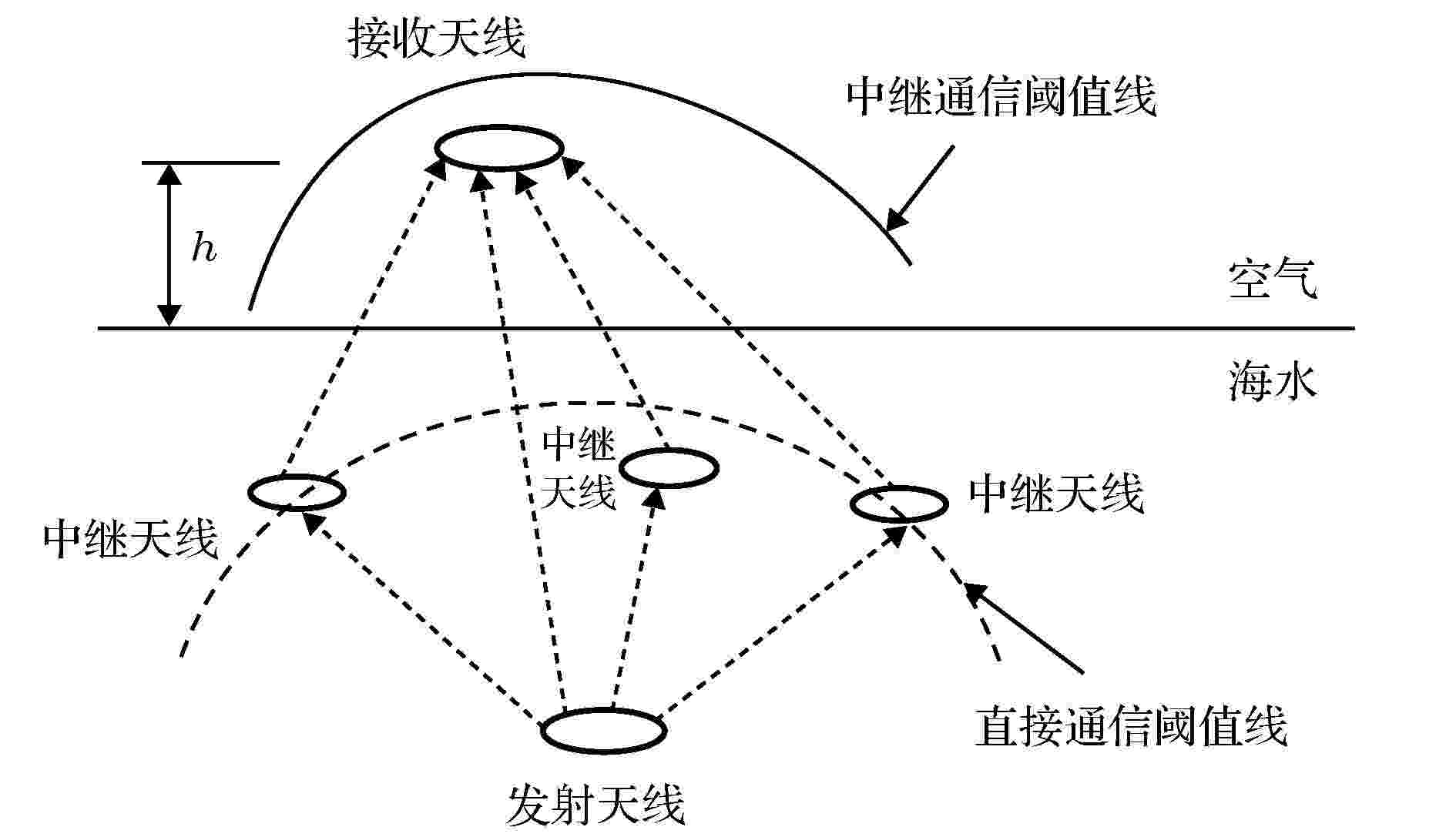
2020, 69 (24): 248401.
doi:10.7498/aps.69.20200882
Abstract +
The transboundary information transmission across the air-and-sea interface is of great practical significance. No matter from the perspective of scientific research or from the view of applications, transboundary communication is a hot and challenging field. Magnetic induction communication has the unique advantages of two-way transboundary transmission, insusceptible to complex hydro-logical environment, and especially suitable for shallow water channel and other environments with harsh propagation characteristics, providing a promising solution for transboundary information transmission. However, the rapid attenuation of magnetic field component with the increase of distance and frequency limits the coverage and transmission rate of the transboundary magnetic induction communication. Therefore, enhancing magnetic field component at a distance has become a focus of magnetic induction communication research. An undersea-to-air transboundary magnetic induction communication scheme based on relay transmission is proposed in this paper, in which a virtual distributed antenna array is formed by processing and relaying the received signals performed at the relay terminals, and the distributed spatial diversity gain can be obtained which is used to enhance the underwater magnetic field component, expand the magnetic induction propagation range, and increase the transmission bandwidth and improve the receiving signal-to-noise ratio as well. Moreover, even in a dynamic marine environment, the relay transmission can be effectively realized and the communication performance can be guaranteed. In this paper, the propagation model of relay transmission based undersea-to-air transboundary magnetic induction communication is established by using the magnetic dipole model in layered conductive media. The effective communication range of direct and relay communication are defined by using their receiving thresholds, and the basic methods and steps to determine the relay location are presented. The communication coverage and available transmission bandwidth of undersea-to-air transboundary magnetic induction communication under different relay scenarios are analyzed and compared by calculating the underwater magnetic induction strength distribution. The numerical results indicate that the underwater coverage and available bandwidth of transboundary magnetic induction communication can be simultaneously doubled under the appropriate number and location of relays. The research in this paper suggests that the relay transmission scheme for magnetic induction communication is suitable for the application in dynamic environment with high propagation loss, which greatly increases the feasibility and effectiveness of the magnetic induction communication as a transboundary communication technology.

EDITOR'S SUGGESTION
2020, 69 (24): 248501.
doi:10.7498/aps.69.20201028
Abstract +
With the miniaturization of molecular devices, high-performance nano devices can be fabricated by controlling the spin states of electrons. Because of their advantages such as low energy consumption, easy integration and long decoherence time, more and more attention has been paid to them. So far, the spin filtration efficiency of molecular device with graphene electrode is not very stable, which will decrease with the increase of voltage, and thus affecting its applications. Therefore, how to enhance the spin filtration efficiency of molecular device with graphene electrode becomes a scientific research problem. Using the first principle calculations based on density functional theory combined with non-equilibrium Green’s function, the physical mechanism of regulating the spin polarization transport properties of single anthracene molecule device with graphene nanoribon as electrode is investigated by molecular oxygen adsorption. In order to explore the effect of the change of the connection mode between single anthracene molecule and zigzag graphene nanoribbon electrode on the spin transport properties of the device, we establish two models. The first model is the model M1, which is the single anthracene molecule longitudinal connection, and the second model is the model M2, which is the single anthracene molecule lateral connection. The adsorption model of single oxygen molecule is denoted by M1O and M2O respectively. The results show that when none of oxygen molecules is adsorbed, the spin filtering effect of single anthracene molecule connecting graphene nanoribbons laterally (M2) is better than that of single anthracene molecule connecting graphene nanoribbons longitudinally (M1). After oxygen molecules are adsorbed on single anthracene molecule, the enhanced localized degree of transport eigenstate will make the spin current of the two kinds of devices decrease by nearly two orders of magnitude. However, molecular oxygen adsorption significantly improves the spin filtering efficiency of the device and enhances the application performance of the device. The maximal spin filtering efficiency of single anthracene molecule connecting graphene nanoribbons longitudinal (M1O) can be increased from 72% to 80%. More importantly, the device with single anthracene molecule connecting graphene nanoribbons laterally (M2) maintains nearly 100% spin filtering efficiency in a bias range from –0.5 V to +0.5 V. These results provide more theoretical guidance for practically fabricating spin molecular devices and regulating their spin transport properties.
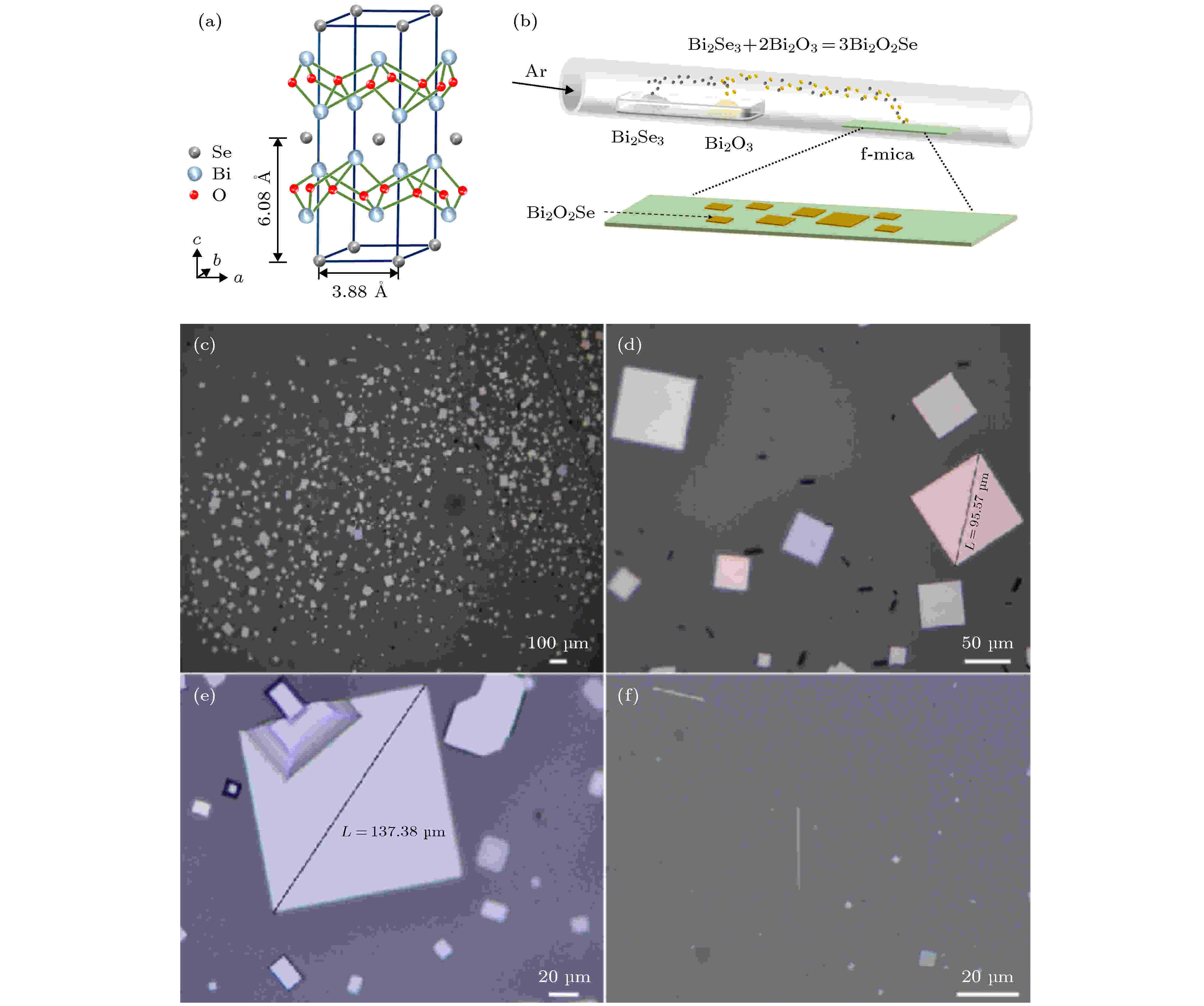
2020, 69 (24): 248502.
doi:10.7498/aps.69.20201044
Abstract +
With the advent of graphene, atomically thin two-dimensional materials receive great attention in both science and technology. However, the characterization of zero-band gap of graphene hinders its applications in semiconductor logic and memory devices. To make up for the imperfection of graphene, one has made efforts to search for other two-dimensional layered materials. The Bi2O2Se is an emerging material with very high electron mobility, modest bandgap, and excellent thermal and chemical stability. In this work, high-quality Bi2O2Se thin films are synthesized through chemical vapor deposition. The effect of temperature on the morphology and size distribution of Bi2O2Se thin film are discussed in detail experimentally. Under an optimized experimental condition, the Bi2O2Se thin films with a lateral size of 100 μm are achieved. Interestingly, Bi2O2Se nanowires are obtained at a lower growth temperature (620–640 ℃). The photoelectric performances of Bi2O2Se on mica and silicon oxide substrate are examined based on a photoconductive mode. At a small bias of 0.5 V, the responsivity and specific detectivity of the rectangular Bi2O2Se thin film on the mica substrate reach 45800 A/W and 2.65 × 1012Jones, respectively, and the corresponding photoelectric gain is greater than 105. The photoelectric performance of our device is comparable to the best results achieved by other research groups, which may be related to the higher quality and appropriate absorption thickness. The Bi2O2Se nanowire and Bi2O2Se thin film transferred to Si/SiO2by a polystyrene-assisted method also exhibit a good photoresponse under the illumination of a 532 nm laser with a high optical power density (127.4 mW/cm2). The experimental results demonstrate that the Bi2O2Se has great potential applications in the optoelectronic devices with low power consumption and high sensitivity.

EDITOR'S SUGGESTION
2020, 69 (24): 248701.
doi:10.7498/aps.69.20200979
Abstract +
Gold nanorods (GNRs) have aroused the extensive interest of many researchers in recent years due to their unique physicochemical properties. However, the toxic cetyltrimethylammonium bromide (CTAB) is often introduced into the process of synthesizing GNRs, which hinders the wide-range applications of GNRs in clinical practice. To reduce the toxicity, the CTAB molecules coated on the surface of GNRs should be replaced by nontoxic and biocompatible agents such as phospholipid. Thus the component and morphology of the mixed coating agents on the surface of GNRs affect the physicochemical properties of GNRs. To study the morphology and properties of the coated GNRs at a molecular level, we investigate the self-assembly of GNRs, CTAB, and dimyristoyl phosphatidylcholine (DMPC) by using solvent-free dissipative particle dynamics simulations. Our results show that the morphology of the assembled complex mainly depends on the CTAB/DMPC molar ratio, while neither of the interaction strength between GNRs and the coating agents nor the diameter of GNRs has significant effect on the morphology. At a certain combination of GNRs-coating agent interaction strength with GNRs diameter, the mixture of CTAB and DMPC on the surface of GNRs undergoes a gradual change in morphology as the CTAB/DMPC molar ratio increases, including the forming of intact bilayer membrane, cracked bilayer membrane, long patches of micelles, and short wormlike micelles winding GNRs in spiral shape. The morphology of intact bilayer membrane verifies the experimental guess, while the other three morphologies are brand-new discoveries. We also find that when the GNR’s diameter becomes smaller, or the CTAB/DMPC molar ratio is larger, or the interaction strength is greater, the agents cap the ends of GNRs, meanwhile the membrane thickness becomes thinner. The multiple morphologies of the assembled complexes can be qualitatively explained by the shape energy of a membrane adsorbed on a solid surface. When the surface tension of the membrane (which is proportional to the spontaneous curvature of the membrane) exceeds a critical value (which is equal to the adhesion energy density of the membrane), the membrane dissociates from the solid surface and its shape changes. The change trend is related to the spontaneous curvature of the free membrane. As a result of the synergy and competition among the inherent curvatures of GNRs, the spontaneous curvature of CTAB/DMPC membrane or micelle, as well as the adhesion energy, various interesting morphologies are produced. Our simulations and analyses directly characterize the morphological structures of CTAB and lipid coated GNRs, which allow us to in depth understand the self-assembling behaviors of GNRs at a molecular level. This is also conductive to achieving the controlled assemblies of GNRs.
GEOPHYSICS, ASTRONOMY, AND ASTROPHYSICS

2020, 69 (24): 249501.
doi:10.7498/aps.69.20200625
Abstract +
A novel signal processing method named adaptive variational mode decomposition with the fractal (AFVMD), which is based on variational mode decomposition and fractal theory, is proposed in this paper for solving a problem that it is easy to misjudge the working conditions of the centrifugal compressor. The measured signal of a compressor is unstable, so a traditional method is used to analyze the nonlinear phenomenon of the stall flutter. Owing to the fact that the robustness of VMD method is strong and its combination with the fractal dimension can accurately describe self-similarity and fractal characteristics of a measured signal, the proposed AFVMD method can not only achieve noise reduction, but also extract nonlinear feature from a complex signal. Taking the dynamic pressure data of the impeller during the instability of a centrifugal compressor as an object to verify the effectiveness and superiority of the proposed AFVMD method, the results are obtained as follows. Firstly, compared with the wavelet noise reduction method, the proposed AFVMD method has both noise reduction and feature extraction functions, and the compressor pressure pulsation spectrum has more significant stall characteristics. Secondly, none of the traditional nonlinear analysis methods can reflect the stall process, so the chaotic phase space attractor is used to visualize the flow field changes. Due to the reasonable choice of the delay time and the embedding dimension, the physical information originally mixed in the signal is separated, so that the attractor phase diagram method has a better process of judging the flow stall than the frequency spectrum method. The results show that the proposed AFVMD method can judge the compressor about to enter into the deep surge earlier. Thirdly, In order to quantify the superiority of the proposed method, if the process of surging and the occurrence of deep wheezing can be predicted in advance, the largest Lyapunov exponent is used as an evaluation index. The above results show that the largest Lyapunov exponent of the proposed AFVMD is smallest for illustrating that the signal has more accurate flow field nonlinear information, which improves the predictability of the signal.
















